













Arecent post from someone I didn’t know kind of reminded me of something.
The post on Instagram was about a visit to a Rolex shop.
And yet there was nothing to walk out the store with.
But what the poster, and his wife, said was that it was nice to be able to see the watches in person, see them and feel them and put them on.
Now this isn’t something new to many of us. It was never really that hard to see most watches. But over the craziness of the last few years and the drawing in of many people more interested in money than watchmaking, we forget that many have been left somewhat hanging.
You would more often go into watch shops to look and talk and dream more than buy. That was actually part of the charm. It would be like a kid going to a toy store or bookstore (for me) checking on something you couldn’t yet get. Seeing if it was still there waiting for you.
Now with everyone focused by algorithms on the same few pieces and a whole world of changing “grails,” a lot of that original authentic charm was gone.
So don’t look at the fact that you can’t buy immediately completely as a bad thing. The
brands and shops aren’t just teasing you. They are responding to a very real market reality. And it pains them that people who would love to see and feel and touch their watches cannot do so.

For many people especially nowadays, watches are about money and bragging rights and such. But for most of the watchmaking world and industry, there is a true and authentic passion. Yes business demands must be met, but numbers are not always the drivers you may think.
I personally did not think about this when I learned the current standards of always having stock in the shops for people to see. I thought it was an intelligent response by the watch companies. And I thought about people who would look at it with frustration.
But that post I mentioned, it made me think. Perhaps I was falling into the “usual response.”
So that original poster (and his wife) was (were?) right. Now more people can go to the shops and see the watches.
Maybe the watch companies aren’t just thinking about people spending their money.
Maybe they are thinking about people spending their time.
And dreaming. carsandcalibres
Carl S. Cunanan Editor-in-chief
“THE BRANDS AND SHOPS AREN’T JUST TEASING YOU. THEY ARE RESPONDING TO A VERY REAL MARKET REALITY.”



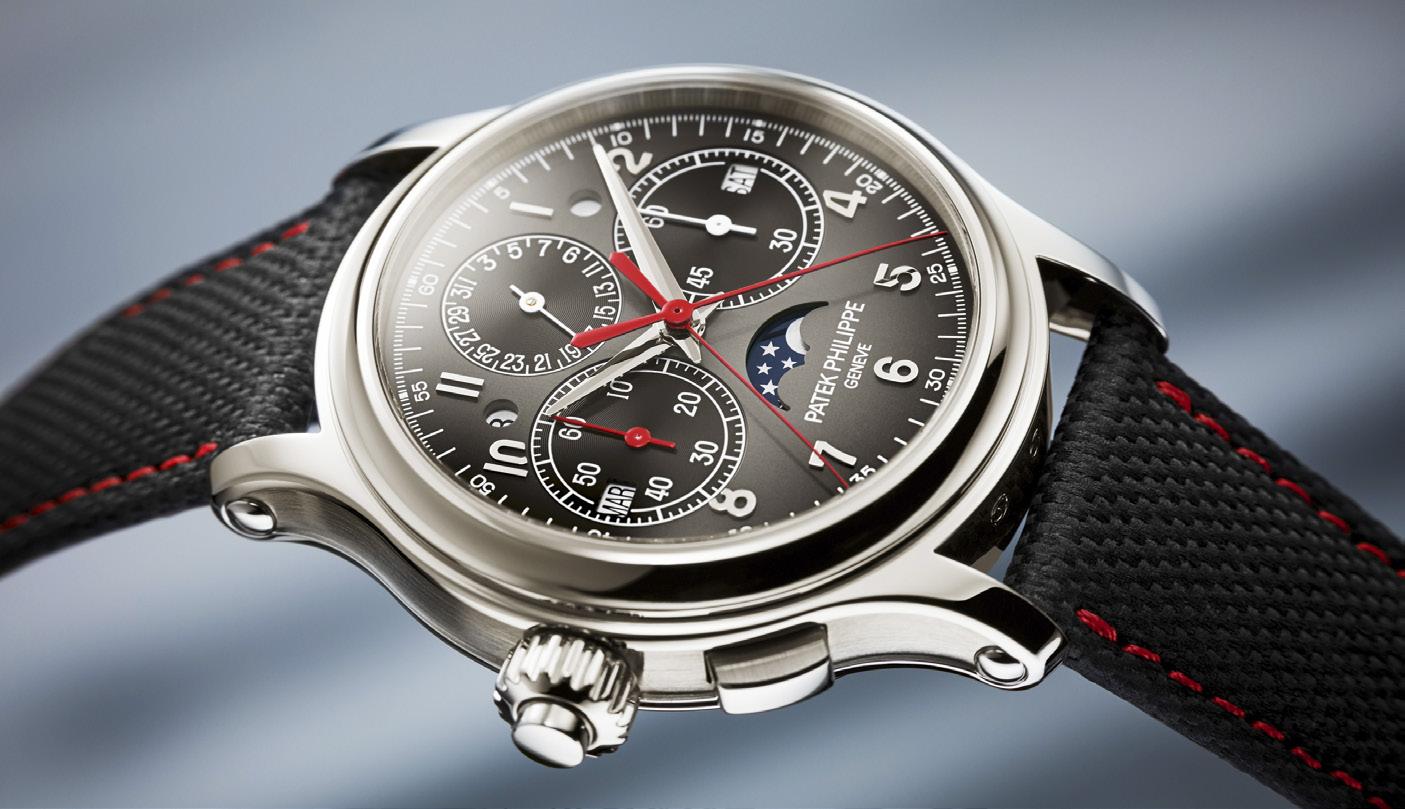



“I’M THINKING BEYOND MY TIME TO THE LEGACY I LEAVE BEHIND.”
GISELE BÜNDCHEN, SUPERMODEL, ENTREPRENEUR, ENVIRONMENTALIST AND IWC ENVIRONMENTAL AND COMMUNITY PROJECTS ADVISOR

Expressive but understated, sophisticated but casual: With a perfect blend of elegance and sportiness, the Portofino Chronograph 39 exudes freshness and purity – a truly versatile timepiece. The IWC-manufactured 69355 calibre ensures precision timing, the ergonomic 39-milimetre case size excellent wearability.





















































 ARCEAU LE TEMPS VOYAGEUR
ARCEAU LE TEMPS VOYAGEUR



The Hermès journey continues towards new dreamlike horizons, where time takes on a singular dimension. Borders are blurred, movement is light and joyful. The hours of the world are an invitation to experience ubiquity – here or elsewhere – as the spirit takes flight, free and borne on the wings of dreams.
The Arceau line designed by Henri d’Origny in 1978 lends itself to a new expression of style and evokes the spirit of travel according to Hermès. Crafted in platinum and titanium or entirely in steel, set with diamonds (or not), its round case with asymmetrical lugs reveals a new reading of the hours of the world.

A gravitating counter journeys across continents, moving from city to city, flying over time zones. As it travels, the face of
the watch is transformed, opening up whole new dimensions. The satellite gravitates on a fantasy map created by Jérôme Colliard for the Planisphere d’un monde équestre silk scarf. A metaphor of the ties between horses and the House of Hermès, this design was inspired by a giant globe created by the French graphic designer for the 2016 Saut Hermès showjumping competition in Paris. This unique interpretation invites you to travel through the imaginary universe of Hermès.
CAsE
Shape/size: Round, 38 mm diameter
Material: stainless steel set with 78 diamonds
Anti-reflective sapphire crystal and caseback Water-resistant to 3 bar
Polished rhodium-plated dial inspired by the Planisphère d’un monde équestre motif designed by Jérôme Colliard. Natural white mother-of-pearl mobile counter. Charcoal grey transferred Arabic numerals. White transferred continent names.
Oceans in openworked natural white motherof-pearl. White transferred meridians and parallels. Blued hands.
Manufacture Hermès H1837 movement
Mechanical self-winding, Swiss made Diameter: 26 mm
Thickness: 3.7 mm
Power reserve: 40 hours
Frequency: 28,800 vibrations per hour / 4Hz
Decoration: Circular-grained and snailed baseplate, satin-brushed bridges and oscillating weight, signature “sprinkling of Hs” pattern, rhodium-plated oscillating weight
Exclusive “Travelling Time” module
Diameter: 32.7 mm (14 ½’’’)
Thickness: 4,4 mm
122 components, 7 jewels Bead-blasted bridges
Hours, minutes, dual-time display with city indication
stRAp
Pearl grey alligator strap
Pearl grey calfskin strap












Executive Editor
Joseph Peter C. Calimbas
Senior Editor
Hernan C. Mapua
Collections Editor
Jason S. Ang
Associate Editor
Kit O. Payumo
Senior Staff Writer
Alberto E. Casal
Editor-at-Large Bryan Martin B. Zialcita
Design Director
Charie L. Biaden
Senior Designer
Mark David A. See Designer
Mary Ann E. Marcelo
Contributing Writers
Katherine S. Cunanan
Jose Martin V. Ursúa
Leonard Vincent L. Ho
Edrich Santos
Dominique O. Cerqueda
Contributing Photographer
Keith Sundiang
Advertising Traffic Manager
Mary Jane O. Salazar
Account Managers
Malyn L. Bautista
Francesca M. Leonardo
Hiroshi D. Paderagao
C! Publishing and Media Group, Inc. Publisher
Chairman Michael L. Lhuillier
Managing Director Paolo M. Puyat-Martel
Board of Directors
Michael L. Lhuillier Paolo M. Puyat-Martel Carl S. Cunanan Kevin C. Limjoco
Senior Accountant Merline B. Urdas
Credit and Collection Officer Mary Ann M. Benito
Legal Counsel
Paredes Garcia & Golez Law Office
C! Publishing and Media Group, Inc.
10 Nathan St. White Plains Subdivision, White Plains, Quezon City, 1110 Philippines Tel: (+632) 7728.3720 to 21 Visit: www.calibremagazine.com
Distributed by: Alphastream Marketing Inc.
#5 Everite St., Calumpang, Marikina City Tel: (+632) 7945-5089
Copyright © 2022
Calibre Magazine PH
facebook.com/calibremagazineph
@calibremagazineph twitter.com/calibremagph
The editors and publishers of this magazine give no warranties, guarantees or assurances and make no representations regarding any goods or services advertised in this edition. No part of this magazine may be reproduced, in part or in whole without written permission of the publisher.





Except for the occasional bouts of COVID-19, the world and everyone in it is rapidly trying to make up for lost time. Almost everything that was set on ‘pause’ 2 years ago has resumed operations and is now doing its best to survive in this new reality. This holds true even for the watch industry.
During the height of the pandemic, demand for certain brands and models drastically went up as people were steadily consuming a daily diet of watch-related content during their forced and prolonged isolation at home. More and more people were introduced and drawn to this shared passion/hobby of ours, as even traditionally conservative watch brands pivoted to digital platforms during this period to keep afloat. To some extent, the pandemic only hastened this move to digitalization since the world was already moving in that direction even before the spread of COVID-19.
This year — thanks to the availability of vaccines and better medicine globally — more and more nations opted to open up their borders to visitors and tourists. The watch industry kept pace with these changing times, and once again started hosting face-to-face events. Watch enthusiasts were now clamoring for more than just another digital release. Everyone needed a break from the virtual world they’ve been living in for 2 years. The real world somehow felt exciting and brand new again.
Unlike the completely virtual Watches and Wonders Geneva event last year, this year,
Martin B. Zialcita Editor-at-Large
visitors (mostly media and other members of the industry) were again allowed to step inside Switzerland and see each and every new release in person. Even local watch events (here in the Philippines) started to happen again, as more and more people have begun to embrace the mindset of living with the virus instead of remaining isolated from the rest of the world.
On a personal level, I’ve been able to take part in a couple of watch-related events this year. First of all, I was finally able to bring to fruition a limited edition flieger I designed in collaboration with Laco for Miata Club Philippines. It took almost a year for us to make this happen, but it was an amazing success and definitely worth the wait.
The latest iteration of the Tudor Ranger is one of those watches that I normally wouldn’t have paid too much attention to. However, Tudor made this new release into a global event that I was fortunate enough to attend here in the Philippines. 2 years of attending virtual releases made this face-to-face event particularly special to me. And it didn’t hurt that the food and wine served was quite good.
Probably the most memorable ‘watch-related’ event for me this year was my trip to Japan. Going watch hunting again (even for a short while) in Tokyo and Yokohama was a great experience that I didn’t think I would be able to do again so soon after being secluded from the rest of the world for 2 whole years.
Life is definitely (almost) back to normal. And that’s a fantastic thing to say after all this time.
Bryan
“LIFE IS DEFINITELY (ALMOST) BACK TO NORMAL. AND THAT'S A FANTASTIC THING TO SAY AFTER ALL THIS TIME.”

My last column was “Sir Malcolm and the Kings of Speed,” and this title was inaccurate in hindsight. That piece focused on Malcolm Campbell and Rolex, but neglected the era’s other Speed Kings. Not even Campbell’s crown rested long on his head and after his Blue Bird reached 300mph in 1935, he retired from land speed record (LSR) attempts and moved to the water. This left the door open for two countrymen, the gregarious Capt. George Eyston and the taciturn John Cobb. Eyston and his Thunderbolt (which took the same gargantuan Rolls-Royce aircraft engine that powered the Blue Bird — then added a second!) took the record in 1937 by a mere 10mph. Top speed honors would then alternate between Eyston and Cobb (driving the UFOlike Railton Special) before war interrupted. In 1947, Cobb returned to Bonneville to better his own record, reaching 394mph. This would stand until the 1960s, when a new generation of LSR cars — propelled by turbojets and rockets — took over.
Returning to the interwar period, many observers were less concerned about record attempts on salt flats and sandy beaches than they were on events occurring in Germany. On the freshly-poured concrete of the Autobahn network raged a battle between two automotive titans, both sponsored by the Third Reich. Unlike the primitive beasts driven by the English gents, the lightweight German Rekordwagen were developed from top-level Grand Prix machinery. Rather than 37L aero engines producing 2300hp, Mercedes-Benz used a 736hp 5.6L supercharged V12, while Auto Union had its 560hp 6.5L supercharged V16. Their streamlined aluminum bodies were designed using the most advanced (but
still rudimentary) aerodynamics theory. Their pilots were not public-school playboys, but the greatest racing drivers of the era: Rudi Caracciola for Mercedes, Bernd Rosemeyer for Auto Union. Adolf Hitler had the notion to promote German superiority in multiple dimensions: best roads, fastest drivers, and technical prowess born of the biggest brains of Untertürkheim and Chemnitz.
From 1934 onward, these two teams fought to set the fastest speeds on the Autobahn. Not to minimize the bravery of the men on the salt, but extreme speeds are far trickier on twolane motorways that become breathtakingly narrow above 200mph. On January 28, 1938, Caracciola clocked a two-way average of 268.8mph, smashing Rosemeyer’s 252.4mph set three months prior. Auto Union responded and tragedy struck when Rosemeyer lost control at over 250mph, crashing violently. The likely culprits were a strong gust combined with aero tweaks that made his Typ C Rekordwagen catastrophically sensitive to crosswinds. Rosemeyer was ejected from the wreckage onto the roadside, dead. Caracciola’s
public-road record would stand until 2017, when a Koenigsegg Agera averaged 277.9mph on a Nevada highway.
One speculates how the Silver Arrows might have performed at Bonneville, but this is a non-starter given the politics involved. Nevertheless, the Nazis wanted the outright speed record, and they intended to set it on a newly paved and widened stretch of the Autobahn. Designated vehicle: The Mercedes-Benz T80, designed by Ferdinand Porsche, newly released from his Auto Union contract. This 6-wheeled monster more resembled the English record breakers, as it was powered by a 3500hp 44.5L DaimlerBenz V12 used by Luftwaffe bombers. Was its target speed of 466mph (750kph) feasible? If so, then the record might have stood until 1964, when Craig Breedlove’s jet-powered Spirit of America could overtake it. But in this alternate history where Poland was not invaded (thus allowing LSR attempts to continue), Caracciola may well have followed Rosemayer to an early grave. CFD studies conducted for the documentary “Hitler’s Supercars” concluded that the T80 was aerodynamically unbalanced, resulting in a high risk of flipping — ironically like the Mercedes-Benz CLRs of 1999.
Martin V. Ursúa Contributing writerAfter 25 years, ThrustSSC still holds the outright LSR of 760mph. There are no challengers on the horizon, other than the perpetually broke Bloodhound project. Intriguingly, the piston-engine, wheel-driven LSR was raised to 470mph in 2020 by Speed Demon, powered by a 3156hp Chevy bigblock. As for Rolex, it would have no other associations with speed record-breakers, other than a positive review of the GMT-Master by Maj. Pete Knight while flying an X-15 at Mach 6.72. It remains the fastest manned aircraft of all time.


Snippets of what's going on in and around the Calibre world
The Cartier Métiers d’Art takes inspiration from the Maison’s powerful and majestic animals
According to MerriamWebster, a menagerie is A) a place where animals are kept and trained especially for exhibition, or B) a collection of wild or foreign animals kept especially for exhibition. Either definition is appropriate in describing Cartier’s tour de force entry at the 2022 Watches & Wonders, a visionary execution in which the Cartier's craftsmen brought the Maison’s legendary menagerie to life, which includes the giraffe, the zebra, and, of course, the panther, Cartier’s emblematic feline since 1914, all in a glorious compendium of enamel, marquetry, and gold bead granulation.
This apparently unbound horological creativity has been brought to life in four incredible timepieces, the first of which is the Crash Tigrée Métamorphoses watch. Created in 1967, this timepiece was originally designed to capture the rebellious attitude of London during the height of the Swinging Sixties and was known back then simply as the Cartier Crash. And endowed with what is possibly the most unique shape in horology, this inclination hasn’t exactly been tempered over the years.
This year, the Cartier Crash once again rears its uniquely rebellious persona to transform into the Crash Tigrée Métamorphoses watch, an organic and vivid representation of the emblematic feline that is so dear to Cartier’s heart by featuring the line’s signature Salvador Dali-esque asymmetrical dial but modified
(believe it or not) to look like a piece of bejeweled tiger skin.
The result is a watch steeped in history and (obviously) meant to be a collector’s item. The Crash Tigrée Métamorphoses watch is limited to only 50 numbered pieces and, this time, draws inspiration from the wildlife of Africa. Colored in hues of turquoise, green and midnight blue (Cartier’s signature color combination), the Crash Tigrée Métamorphoses watch is the first Crash ever to be enamelled and is, in fact, the beneficiary of several, often
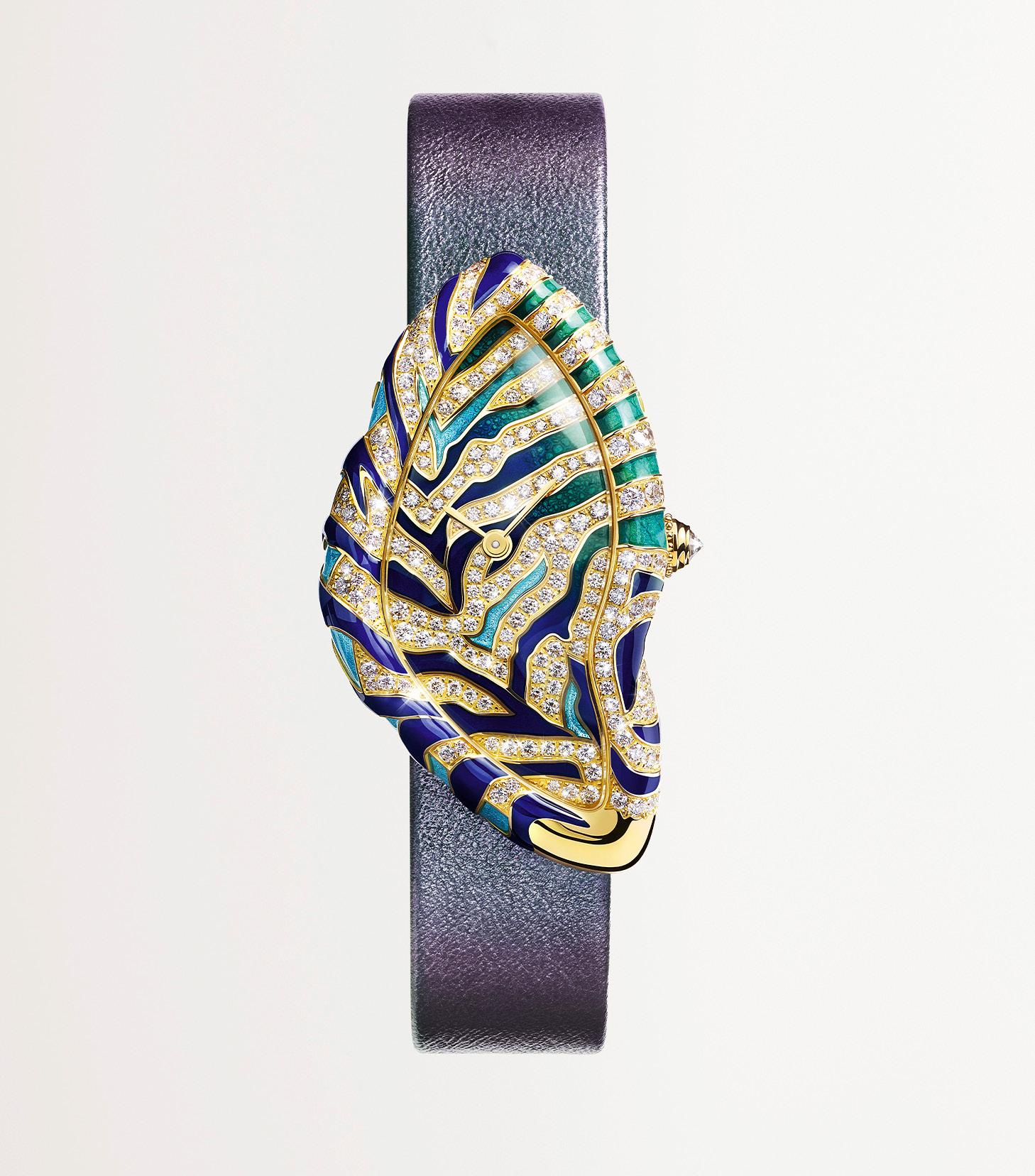
unprecedented enamelling techniques that the Cartier artisans made use of including opaque, translucent, gradient, as well as silver pailletes and engraving.
Powered by the manual winding 1917 MC Manufacture mechanical movement, the Crash Tigrée Métamorphoses watch is a delirious cocktail of champlevé enamelling, 18K gold and diamonds, and is set off with another Cartier signature: a winding crown set with an inverted pavilion diamond. It more than earns its title as “the most striking timepiece at Watches & Wonders 2022.”
Next up is a Cartier watch with dual animal magnetism. More specifically, the Ronde Louis Cartier Zebra and Giraffe watch features the hyper-realistic black and white profile of a zebra on one half of the dial, and an abstract motif that evokes the spotted coat of a giraffe on the other.

An elated mix of marquetry and bead granulation, the former is used to outline the profile of a zebra with stripes made of tiny slivers of white mother-of-pearl and black onyx and rendered in a highly stylized manner by Cartier artisans.

The latter, on the other hand, uses the gradation of six different shades of rose and yellow gold beads to abstractly render the giraffe’s spotted coat for the first time, the grid-like jewelry structure of which is lit up by seven collet-set diamonds.
Further, the bedazzling bezel on the 36mm rhodium-finished white gold case is a combination of 26 diamonds, 6 yellow sapphires and 9 orange brilliantcut garnets, as well as the black lacquer where the zebra coat spills out from the dial, while the crown is once again set with an inverted pavilion diamond.
A design featuring patterns of fire and flames, the Ronde Louis Cartier Gold Fragments is another tour de force of enamelling, this time mixed with a gold leaf and powder to present the Maison's eternal muse, the panther.
Indeed, the animal’s profile is cut out on a gold leaf only a few microns thick and placed between several layers of black and translucent enamel, which hardens when fired. Translucent pink enamel is then added to the mix, as well as various shades of colors and forms made with gold powder. Adding contrast to the fiery dial is a 42mm yellow gold case, which only adds to the intensity of the rendering, and features a bezel and buckle set with 103 brilliant-cut diamonds. A crown set with a brilliant-cut diamond adds the finishing touch, as do the black and blue alligator leather straps.
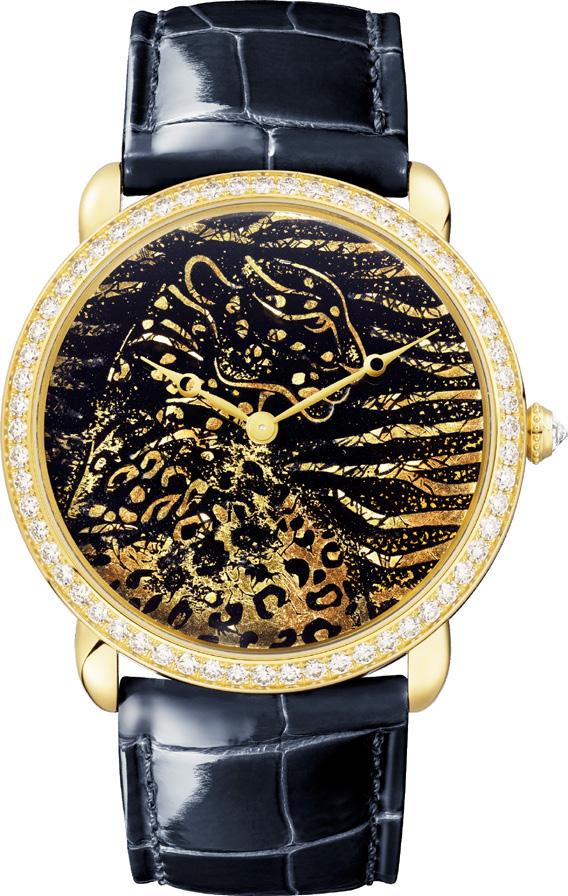

Rounding out this year’s Cartier Métiers d’Arts collection is the Ronde Louis Cartier Sparkling Panthère, a more masculine take on the Maison’s signature panther in a dazzling depiction of hard lines and angles in an interplay of dark and light. One of the most modern executions of marquetry ever attempted, the gold geometric grid on the dial is inlaid with 16 blades of straw, 8 pieces of wood, 36 gold elements, 16 sapphire crystal fragments, and 48 mother-of-pearl segments. And did we mention the 2 pear-cut collet-set diamonds that make the eyes?
Indeed, the virile animal peering out of the Ronde Louis Cartier Sparkling Panthère is unlike any Cartier panther seen before, and is matched with a masculine 42mm rhodium-finished white gold case set with a sapphire cabochon crown. A shimmering black alligator leather strap adds that final touch.
These last three watches from the Cartier Métiers d’Arts collection are even more exclusive than the first Crash Tigrée Métamorphoses watch and are extremely limited editions of only 30 individually numbered pieces each, all three of which are powered by the same manually wound 430 MC mechanical movement developed and manufactured entirely by Cartier.
How can you choose just one?
The Three Graces is a reference in Greek literature, then represented in both sculpture and art.
The painting by Raphael and the sculpture by Canova are two of the most famous works of art on the three sisters. Each Grace is said to represent a daughter of Zeus and the gift they were meant to bestow on humanity: happiness, youth, and elegance.
Imagine, if you will, three sisters similarly beautiful yet somehow still individually distinct. The Rolex Oyster Perpetual Datejust 31 is an ideal representation of these same graces. Each model is as beautiful as the next, yet each is also unique.

The three new Rolex Oyster Perpetual Datejust 31 have different striking floral-motif dials. The blooms on the dial — 2 dozen, to be exact — have varying treatments that make each flower distinct, so you can imagine yourself gazing across a meadow of flowers in the warm sun. The flower petals have either a grained, matte, or sunray finish, and at the center of each flower is a dainty diamond.

The Rolex Oyster Perpetual Datejust 31 with an olive-green dial has an 18ct yellow gold case with a diamond-set bezel, and 18ct yellow gold hands. The 46 brilliantcut diamonds on the bezel, totaling more than a carat in weight, add more sparkle to this delightful watch. The green and gold color palette is playful and reminiscent of nature. The 18ct yellow gold bracelet here has three links, in the President bracelet, meaning slim links with ceramic inserts. The center link is polished while the outer
Model no.: 278288 RBR Model no.: 278274 Model no.: 278381RBR
links are satin-finished. This watch seems to represent the Grace of happiness.
The Rolex Oyster Perpetual Datejust 31 with an azzurro-blue dial has an Oystersteel and white gold case with a fluted white gold bezel, and white gold hands too. The blue and white color pairing is both clean and modern. The fluting on the bezel seems to mimic the sparkle from diamonds at the center of each flower on the dial. The watch has the Oyster bracelet, also three-link style, in Oystersteel. The center link is polished while the outer links are satin-finished. Perhaps this watch represents the Grace of youth.




The Rolex Oyster Perpetual Datejust 31 with a silver dial has Oystersteel case and a diamond-set Everose gold bezel, and Everose gold hands. Similar to the olivegreen dial version, the diamonds on the bezel here total over 1 carat in weight. The case and bracelet are in a two-tone style, with the Jubilee bracelet of five links. The three center links are polished Everose gold while the Oystersteel outer links are satin-finished with polished edges. This watch is the epitome of the third Grace, elegance.
The Rolex Oyster Perpetual Datejust 31 is powered by the calibre 2236, which is manufactured by Rolex. The mechanical movement has an oscillating rotor that will wind the watch as you go about your normal daily routine. The watch is a threehander, meaning it displays the hours, minutes, and seconds; it also has the date window at the 3 o’clock. Of course as a Rolex, the watch has the Superlative Chronometer certification, guaranteeing excellent performance. Each watch has a power reserve of roughly 55 hours, and is water resistant to 100 meters.
The Rolex Oyster Perpetual Datejust 31 is an elegant and timeless beauty, and with the three additional versions to the family, picking one is a delightful task.
And that’s because the famous Black Bay aesthetic that we all know and love has evolved into something entirely cultured and urbane. That’s right, the stainless steel cases of the new Black Bay 31, 36, 39 and 41 S&G models have eschewed their utilitarian, tool-watch persona to showcase not only a two-tone color scheme but are now enhanced by seductive curves never before seen in the Black Bay line.

These curves are presented front and center by polished and domed sides in all the available sizes, as well as a fixed bezel in polished yellow gold, the color/precious metal combination of which is echoed by the curved screw-down winding crown, and the five-link bracelet also in steel and yellow gold. Indeed, these new models recall the style and aesthetic of vintage dress watches, which quite possibly make

them the dressiest models in the entire Tudor Black Bay lineup. And with case sizes ranging from the downright petite 31mm all the way up to a more substantial 41mm, the watches in the new Black Bay S&G line up are sized “just right” and offer something for every wrist size.
Further, these new models come standard with black, silver or champagnecoloured dials and are bedecked by standard Tudor flourishes including "Snowflake" hands, introduced way back in 1969, with Grade-A Swiss SuperLumiNova® luminescent material, as well as the aforementioned five-link bracelet in 316L steel and yellow gold with a robust clasp also in 316L steel. Best of all, the clasp is equipped with the practical Tudor “T-fit” with rapid adjustment that allows the wearer to carry out a fine, instant adjustment of up to 8mm on the clasp without the need for tools.

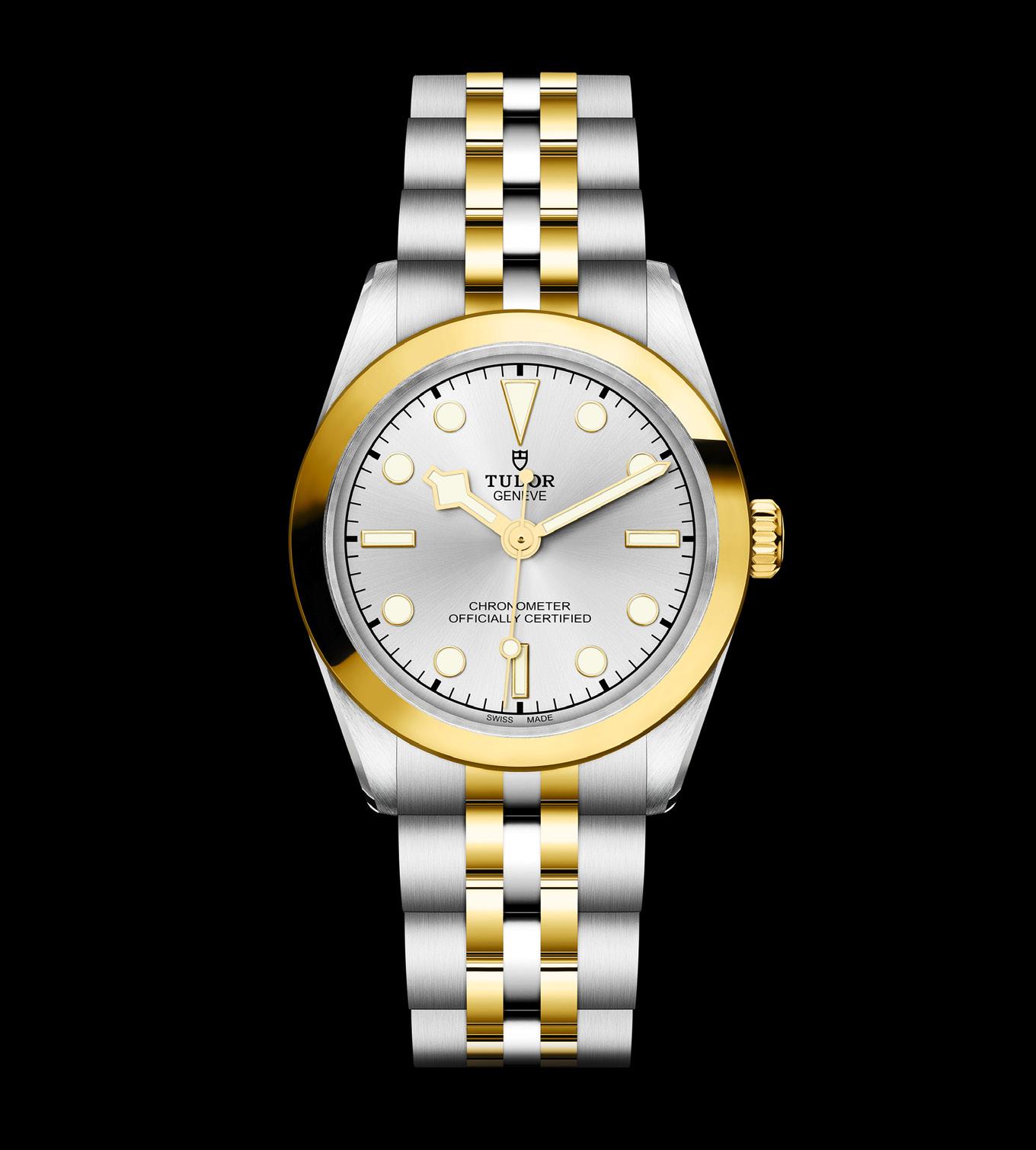


All the new Black Bay 31, 36, 39 and 41 S&G models are driven by Manufacture
Calibres that have benefitted from the development of the Manufacture Calibre MT5201, which was specifically developed to power watches with smaller dimensions. Thus the four self-winding movements: MT5201 for 31mm, MT5400 for 36mm, MT5602 for 39mm and MT5601 for 41mm ensure robustness, longevity, reliability and precision throughout the entire line of new Black Bay S&G watches with variable inertia balances, non-magnetic silicon balance springs, and chronometer certification by the Official Swiss Chronometer Testing Institute (COSC).
Power reserve is also respective of the range with 50 hours for the smaller Calibre MT5201, and “weekend-proof” for the large and medium sized Calibres with 70 hours of power reserve. Last but not least, the 31, 36, and 39mm sizes of the new Black Bay S&G line also comes with a diamond-set bezel option, a nice little detail that will surely enhance this new Black Bay’s sparkle on the wrist.



Vacheron Constantin’s 222 occupies an odd spot in the horological firmament. For years after its release it was considered a cult classic, never fully understood by collectors as a whole and never reaching the iconic status enjoyed by a handful of rival watches. Part of the 1970s revolution of stainless steel, integrated-bracelet designs, the 222 is often mentioned as an afterthought in a quartet of legends — the Ringo of the bunch. Comprising the rest of the Fab Four were the Audemars Piguet Royal Oak (Ref. 5402), the Patek Philippe Nautilus (Ref. 3700), and the IWC Ingenieur SL (Ref. 1832). These three were avant-garde timepieces penned by the iconoclast designer Gérald Genta, with the shock success of 1973’s Royal Oak leading to the debuts of the other two in 1976. It was thus assumed that the 222 had a similar story, and that it was Genta’s fourth assault on the Swiss status quo cloaked as a celebration of the oldest watchmaker’s eleven score and second anniversary. But was it really?
Here I must shift to first-person narration, because I owe long-time Calibre readers an apology. In a 2011 article about the Vacheron Constantin Overseas, I wrote about the mysterious origins of the model’s ancestor, the 222. I had essentially defended the conventional wisdom that it was a

Genta design, casting doubt on the then-recent claim that Jörg Hysek had been named as the 222’s designer in factory records. Just 24 years old at the time of the 222’s release, Hysek would later build his reputation at several companies, designing watches like the TAG Heuer Kirium and the Breguet Marine, before establishing his own companies (Hysek, then HD3 Complication). My counterargument was that the 222-Hysek claim was an assertion by just one person (a moderator on a VC-focused website), uncorroborated by any official document or employee. But a lot can change in 11 years, and Vacheron Constantin has since set the record straight. The Maison’s press materials give full credit to Herr Hysek, and also emphasize that the 222 was a natural follow-up to 1975’s Chronomètre Royal, Vacheron Constantin’s first all-steel, integrated-bracelet watch. The 222 would be sold in a selection of sizes (34mm and 37mm) and materials (yellow gold, white gold, two-tone, and steel), in addition to 25mm Quartz and 31mm squarecased models. However, the 222 would enjoy only a brief production run of eight years, eventually being replaced by the even shorter-lived 333 and the forgettable Phidias.

“The 222's appeal is immediately apparent: It is arguably the most subtle of the four integrated-bracelet design icons of the 1970s.”
Forty-five years on and Vacheron Constantin has unveiled a near-perfect replication of its 70s showstopper with the Historiques 222 (Ref. 4200H). So what has spurred this comeback? Could it be the fortuitous numerology of the year 2022? Perhaps it’s due to the increased profile of the 222 in recent years, thanks to regular coverage in print and electronic media? Or maybe it can be explained by the sky-high demand for the Nautilus and Royal Oak, and Vacheron Constantin wanting to get a piece of that action while the getting is good?


Whatever the reason, the announcement of the new 222 was met not with arched eyebrows, but with universal approval. It was an instant blockbuster at this year’s Watches and Wonders, with many wags calling it the most anticipated watch of the show.

For an 18K yellow-gold sports/luxury watch with design language from half a century ago, the Historiques 222’s appeal is immediately and broadly apparent even to the current year’s sensibilities. Arguably the most subtle of the aforementioned Fab Four, the 222 has less of the bulk and brutality of Genta’s three legitimate children. In many ways, it shares more cues with the Rolex Oysterquartz — the revolution’s Fifth Beatle, as it were. The 222 also lacks the aggressively impractical elements of GG’s designs, such as the Royal Oak’s bezel screws that do not turn, the Nautilus’ left-hand “crown guards” that guard no crown, and the purely decorative holes on the Ingenieur’s bezel.
Owners of the current Overseas will spot the family resemblance in the tonneau-shaped midcase, the blocky lugs that sharply angle toward the wrist, and the bezel fluting that has evolved into the broad scallops found on the VCO. In
the lower-right corner of the midcase is an engraved Maltese cross that reminds one of the BMW roundel tucked into the C-pillar of an E9 coupe. Brush-finished on the original 222, this white-gold cross at 5 o’clock is now polished to a high gleam. Otherwise, the Historiques 222 is finished in a manner that is faithful to the original, with almost all surfaces brushed, punctuated by polished bevels that catch the light. Like the Overseas that it spawned, the 222 wears surprisingly slim on the wrist. Dimensionally, it is almost a match to the 37mm original, though the midcase has gained nearly 1mm to become 7.95mm at its thickest. Another subtle change is the thinning of the bezel’s inner circumference. This, combined with a thicker sapphire crystal, appears to have opened up the dial and brightened its outer edges. On the rear are two significant departures from the original: For aesthetics, the caseback now frames a sapphire display window. For practicality, that caseback is now a separate piece. The original 222 had a frontloader monobloc case, meaning that a watchsmith needed to remove the sapphire crystal and the screwdown bezel to access the movement. The trade-off is a reduced depth rating of 50m (from 120m), which should be more than adequate for accidental dips into the swimming pool.
The matte golden dial stays true to the source material, and is nearly identical in both layout and details. Eagle-eyed

readers will note the “SWISS MADE” at the bottom (rather than simply “SWISS”) and a smaller date window that sits further inboard. The latter is due to a change of movement, and it means that the minute track is now unobstructed. Text and markings are unchanged but appear a little taller and bolder than before, resulting in a dial that feels a little less spacious. These are minor changes and might only be spotted in a sideby-side comparison, but they all add up to an uncanny feeling of not-quite-déjà vu. The gold baton hands are unchanged, other than their use of Super-LumiNova instead of tritium. There are only two of them, as befits a proper dress watch.
Under the dial is the biggest divergence between the original and the new 222. Nestled within the case is Vacheron Constantin Calibre 2455, replacing the Cal. 1121 that can trace its roots back to 1967’s Jaeger-LeCoultre Cal. 920. This family of movements would be adopted by AP and Patek Philippe for their Royal Oak and Nautilus, and remains the world’s thinnest automatics with full-size rotors. The “new” in-house Cal. 2455 has been in use for 15 years and is a bit chunkier than its predecessor (thickness is 3.6mm vs. 3.05mm), but it provides a host of benefits to the 222’s wearer. Cal. 2455 ticks at a smoother 28,8000 bph (vs. 19,800 bph) and features a quickset date, which is an expected convenience for most modern watch buyers. However, its power reserve is unchanged from the original’s, at an adequate 40 hours. Lastly, the open caseback places a new emphasis on the movement’s finish — particularly on the rotor. This yellow gold semi-circle is decorated with fluting that echoes that on the bezel, and is engraved with the same disco-font “222” that used to be found in the center of the original’s solid caseback.
A glance at the bracelet provides the quickest tell between the Historiques 222 and the vintage model. The original 222 was equipped with a basic clasp: two curved steel blades and a flip-lock, as could be found on, say, a contemporary Rolex Submariner. Made by the prolific bracelets supplier Gay Frères, the old safety clasps were lightly stamped with a Maltese cross. On the new 222 is a more robust butterfly clasp similar to that found on the current Overseas, and fastening this clasp joins two halves of an engraved Maltese cross. Less visually obvious are the quality improvements on the entire bracelet. Although it retains the same simple geometric design as the original, improved tolerances and materials impart a sense of greater solidity and comfort on the wrist.

Timelessness is overrated. With the reintroduction of the 222, Vacheron Constantin offers a watch that is the opposite of timeless, and very much a product of 1977. After all, we are creatures that respect the linear passage of time. What is not linear is fashion, which remains on its relentless cycle. Judging from current values on similarly “dated” timepieces, the Seventies have never been more appreciated than they are at present. For the 222 and especially its designer, these are accolades that are long overdue. The Historiques 222 redresses that injustice and emerges as one of the year’s hottest watches — at least, until the announcement of the stainless steel model.

The oscillating weight of Calibre 2455/2 was specifically developed for this model and is engraved with the original 222 logo, surrounded by a fluted motif echoing the bezel.

Every issue, we try to bring the timepieces that we've seen at the shows and in different events we've attended both locally and overseas. These are the pieces that have caught our fancy and we hope they catch yours as well.

What is more exclusive than a Patek Philippe Split-Seconds Monopusher Chronograph with Perpetual Calendar? A left-handed one.
 Words by Kit Payumo
Words by Kit Payumo

hat’s right, the already highly exclusive Ref. 5372 Split-Seconds Monopusher Chronograph has been modified to specifically appeal to “southpaws” (that’s left-handers for those not in the know). Now designated the Ref. 5373P-001, the new model is being produced in even smaller numbers and is an even more refined timepiece for connoisseurs of elaborate mechanical movements and horological rarities.
But this isn’t the only left-handed timepiece to make its debut this year. Another fine example is the left-handed Rolex GMT-Master II (ref. 126720VTNR), which just goes to show that the powers-that-be haven’t forgotten about the right-hand wrists of left-handed connoisseurs. And considering left-handed people only make up about 10% of the population, that’s quite a significant investment.
And before anyone starts screaming “copycat!” and start accusing Patek Philippe of simply “following the leader,” the new Ref. 5373P-001 was actually directly inspired by a specially commissioned watch from way back in 1927. Yes, the one-of-a-kind piece was custom-made for a very special client and was a cushion-shaped split seconds chronograph with movement No. 198 012. This historical watch had its chronograph pusher at 9 instead of 3 o'clock and the splitseconds pusher at 8 instead of 2 o’clock. Its silver dial with black Breguet numerals was also reconfigured to reposition the 30-minute chronograph counter from 3 to 9 o'clock and the subsidiary seconds from 9 to 3 o’clock.
In fact, that particular piece came up for auction at Christie’s Geneva in November 2006 and sold for an incredible CHF2,372,000.00, making it the seventh most expensive watch ever sold at auction at the time. If Patek Philippe ever needed street cred on left-handed timepieces, that was it.
Sportier than ever before, the new Ref. 5373P001 Split-Seconds Monopusher Chronograph

Perpetual Calendar is also a direct descendant of both the manually wound calibre CHR 27-525 PS, the world’s thinnest column-wheel-controlled split-seconds chronograph movement launched in 2005; and its successor the caliber CHR 27-525 PS Q launched in 2010 (with the same base movement plus an extremely thin calendar module). Not only does it have a height of only 7.3 mm, but it also set the world record for the thinnest split-seconds chronograph movement with perpetual calendar. Indeed, this exceptional caliber has been crafted in very small numbers
since 2017 (thus, highly exclusive), and ticks in a platinum watch with a blue sunburst dial in the Ref. 5372P-001, or a rose gilt dial with a vertical satin finish in the Ref. 5372P-010
Having a destro configuration (suddenly, we all have a new Italian word in our vocabulary) the pushers and indications of the new Ref. 5373P001 have been flipped over to the left side… just like the historical watch from 1927. But the case and dial configuration wasn’t just flipped longitudinally it was flipped on its latitudinal axis as well. This means not only does the crown with its integrated monopusher now reside at the 9 o’clock position, but the split-seconds pusher also
moves from its former 2 o’clock position to its horological opposite at 8 o’clock. The same goes for the dial, not only have the subsidiary seconds and 60-minute counter swapped places and now sit at 3 o’clock and 9 o’clock, respectively; the analog date and moon phase have swapped as well with the former sitting at 12 o’clock and the latter at 6 o’clock.
Even the calendar indications have swapped with the days of the week moving to its opposite at 3 o’clock, and the months at 9 o’clock; while both the leap year and day/night indicator have moved to the upper half of the dial to still flank the analog date at 10:30 and 1:30, respectively. Finally, that
little detail that marks all of Patek Philippe’s solid platinum watches was included in the move. That’s right, the small brilliant-cut diamond that usually resides at 6 o’clock on the caseband is now set at 12 o’clock to mark the fact that this is an exceptional watch made for left-handers.
Speaking of which, while the diameter of the new watch’s platinum case is still 38.3mm, the dial is a completely different story making the Ref. 5372P-001 look like an entirely different watch. Gone are the elegant sunburst blue and rose-gilt dials of the previous models, replaced by a more aggressive charcoal colored dial with a vertical satin-finish. This sporty aspect is only compounded by a black gradation to the periphery of the dial and the snailed ebony-black subsidiary dials.
And while the applied Arabic numerals and faceted Dauphine hour and minute hands in

white gold are undoubtedly sophisticated, the three chronograph hands: the center and splitseconds hands, as well as the 60-minute counter hand at 9 o’clock, are all rendered in fire engine red. And we haven’t even mentioned the choice of strap: there’s nary a trace of alligator scales to be found here. Instead the 5373P is matched with a black calfskin strap with an embossed textile pattern with bright red contrast stitching and a platinum fold-over clasp to boost the 5373P’s undeniably sporty aspect.

Flip the watch over, and the fantastic architecture of the caliber CHR 27-525 PS Q movement with its two column wheels that bear two polished caps in typical Patek Philippe style come to the fore. Indeed, with its carefully chamfered bridges decorated with côtes de Genève and polished edges, as well as the focus on the bridges à l’ancienne, the interior angles
of which could only be completed by hand, the movement arguably never looked this good. And while the sapphire display caseback is considered standard issue, Patek Philippe also offers an additional solid-platinum caseback that can be engraved and swapped onto the watch if the customer so desires.
Alas, Patek Philippe also announced that moving forward, this watch will be the only model to feature this movement, and that both the Ref. 5372P-001 and the Ref. 5372P-010 have been retired from the collection. But right-handers don’t fret, you’ll find this destro Split-Seconds Monopusher Chronograph easy to manipulate as well. Just strap the watch on your left wrist, use your thumb instead of your fingers to work the two pushers and not only will you be good to go, you’ll also have the bragging rights of owning one of the rarest timepieces of its kind!

“AN EVEN MORE REFINED TIMEPIECE FOR CONNOISSEURS OF ELABORATE MECHANICAL MOVEMENTS AND HOROLOGICAL RARITIES.”
nd that outfit is made of titanium. That’s right A. Lange & Söhne (ALS) just released the third model of their provocative (divisive?) ODYSSEUS collection at the 2022 edition of Watches & Wonders Geneva. And we say provocative because since making its debut in 2019, many watch “experts” have been unsure as to what to make of the German watchmaker’s line of sporty watches.
“Specially conceived for sports and leisure activities,” the ODYSSEUS was designed from the get-go “for ambitious individuals who want a watch that accompanies them in life’s most memorable moments.” For ALS this translated into the artisanally “perfect” timepiece, which not only reflected the type of conservative and traditional watchmaking that the German watchmaker has been painstakingly cultivating since their rebirth in 1994, but which was also so robust and waterresistant that it can be worn during any leisure and sports activity you could throw at it. Anyone with even just a passing familiarity with the German brand would know how disparate those two goals actually are.
Obviously, ALS wanted to get into the high-end luxury sports watch bandwagon that the likes of Audemars Piguet, Patek Philippe, and Vacheron Constantin with the Royal Oak, Nautilus, and Overseas are the obvious kings of. But they wanted to do it with their own “secret” sauce in a less Genta-esque, and more Teutonic way.

A. Lange & Söhne just gave their sports watch a new lightweight outfit

So, two birds one stone, which is fine on paper, but, for many, was somehow lacking in execution. Apparently, its not as easy as one would think because the result was the inaugural stainless steel ODYSSEUS from 2019, which, while will never be suspected as a Genta piece, was a watch that many experts agreed was good but “not quite there.” Indeed, the first stainless steel ODYSSEUS was somehow less than the sum of its parts. All the individual parts were outstanding, to be sure. But the final product lacked that certain X-Factor that others of its ilk had copious amounts of.
But, as they say, “third time’s a charm,” and A. Lange & Söhne may have finally found the secret ingredient that will finally make the ODYSSEUS fly: titanium. Coming after the white gold ODYSSEUS from 2020, this third entry into the ODYSSEUS family may not only be the best of the collection so far, but also happens to be the German watchmaker’s first watch forged in titanium, and that includes its integrated multilink bracelet. To think, most traditional high-end watchmakers rarely use titanium and save the material only for their most special, ultra-high-end watches. This makes the use of titanium on a sports (sports adjacent?) watch even more significant.


And the decision to employ titanium for both case and bracelet had to do with the special properties of the material. Titanium weighs about 43 per cent less than stainless steel, clearly
improving the already high level of comfort of the ODYSSEUS on the wrist. And since the new watch retains the same shapes and proportions as its two forebears: 40.5mm in diameter and 11mm in height, the titanium-clad ODYSSEUS hugs the wrist even less noticeably. Best of all, titanium is extremely robust and like the stainless steel and white-gold versions, the titanium ODYSSEUS has a water-resistant case with a screw-down crown that can handle a test pressure of 12 bar.
Further, when exposed to oxygen, it produces a very thin transparent oxide coating that protects the material against external factors making it corrosion-resistant. More importantly its warm glow has a unique patina that comes to the fore with a combination of polished, matte, and brushed surfaces. Which brings us to why this third ODYSSEUS flies so much higher than the first two models: it just looks so much better.
The new ODYSSEUS has the most detailed and arguably the best finished titanium case ever seen on a watch, and that’s no exaggeration. First of all, the material is micro-blasted, resulting in a case and bracelet that are almost but not quite completely matte. Somehow the ALS watchmakers have found a way to bring out a glow to the material that makes the brushed decoration on the stainless steel and white gold versions look downright dull. Polished titanium has a bright but curiously cold color. The microblasted titanium on the ODYSSEUS has a darker, greyish tone, and when combined with finely polished accents merely emphasize the contrast.
Indeed, the attention to detail lavished by the ALS watchmakers on the case and bracelet of this ODYSSEUS is second to none. The case flanks, for example, as well as the edges of the integrated pushers, and the chamfers on the bracelet links have all been painstakingly individually polished by hand, which when combined with the ultrasoft matte finish of the surfaces these sharp, polished, and reflective edges have resulted in a kind of aesthetic experience never before felt while wearing a watch.
And nowhere on the watch is this contrast more pronounced than on the five-link, screwless integrated bracelet. It forms a harmonious entity with the case, and thanks to a safety clasp equipped with a precision-stepped, easily operable micro-adjustment mechanism, the length of the bracelet can be adjusted by as much as 7 millimeters by simply pressing on a pusher on the side of the safety clasp.
Indeed, its been reported that the amount of time involved in the finishing and production of the titanium bracelet alone is one of the reasons A. Lange & Söhne opted to release this new titanium ODYSSEUS as a limited edition of only 250 individually numbered pieces.
But the painstaking finishing didn’t stop there. The dial also has its fair share of updates, first and foremost of which is a new dial color. In keeping with the other versions of the ODYSSEUS family this titanium edition also features a multi-piece dial but in a new ice-blue color, which is an attractive shade of cyan that
tames the striking blue dial of the inaugural stainless steel model. Best of all this new cool blue tone all the better brings the finishing of the overall watch to the fore.
And that's not all: unlike the inaugural steel version, which featured an hour chapter ring with a classic concentric pattern, this new titanium edition updates this decor with fine guillochéd grooves that seem to emanate from the notched baton-shaped applied hour markers made of polished white gold and filled with a luminous compound. These grooves have the distinct effect of making the hour markers look heavy and seem embedded (like a weight on a soft cushion) as opposed to simply resting on the dial surface, which they actually are.
Further, this has the added benefit of amplifying the three-dimensional effect of the multi-piece dial, especially when the grooves are echoed on the scale of the subsidiary seconds dial. And we haven’t even mentioned the irregularly

structured inner areas of the main and subsidiary dials, the surfaces of which contrast with the uniform lines. The sporty nature of the watch is further emphasized by prominent Lange-typical lance shaped hour and minute hands and an argenté-colored flange ring with a minute scale, which adds lucidity to the dial and features fiveminute Arabic numerals in black with the number 60 standing out in red as a color accent.
As before, the titanium ODYSSEUS is powered by the same Lange manufacture Calibre L155.1 DATOMATIC, which is the only movement A. Lange & Söhne has ever created that runs at 28,800 semi-oscillations per hour or 4 hertz. It can be admired through the sapphire-crystal caseback and features a skeletonized and partially black-rhodiumed central rotor with a centrifugal mass in 950 platinum to deliver an ample power reserve of 50 hours when fully wound.
Further, the oscillation system is designed for superb rate stability. For this purpose, the balance

has been aerodynamically optimized with recessed poising screws and is firmly suspended beneath the balance bridge rather than a balance cock. Together, the higher rate and bridge increase durability (this is a sports watch, after all).

As always, the movement is assembled twice in line with Lange’s philosophy and all 312 parts of the movement are lavishly hand-finished. This includes the bridge, which is manually engraved with a stylized wave pattern evoking the water-resistance of the watch, the German-silver plate decorated with Glashütte ribbing, and the screwed gold chaton that marks the position of the escape wheel.
One caveat though, this new titanium limited edition costs significantly more than both the inaugural steel, and white gold versions. But since this is the most compelling ODDYSSEUS yet, and one of the best-finished titanium watches in the market, maybe the uptick in price isn’t too much to ask.
“The new ODYSSEUS has the most detailed and arguably the best finished titanium case ever seen on a watch.”

 Words by Kit O. Payumo
Words by Kit O. Payumo
Looks like the industry’s “serial horological innovator” is up to its old tricks. That’s right, Roger Dubuis is at it again and they’ve teamed once again with one of their old co-conspirators, which also happens to be one of the flashiest tire makers in the world.
Pirelli makes some of the best tires in the market and has, in fact, created some of the most specialized tires for some of the most extreme cars ever made. Indeed, Pirelli is the go-to tire maker to some of the most high-end automobile manufacturer’s in the world. So yeah, a Roger Dubuis and Pirelli team-up has always been a match made in heaven.
“Driven by a desire to create adrenaline-charged masterpieces, the partners show once again what happens when the finest minds from different industries come together to share their unrivalled know-how, breakthrough research, and boundless creativity.”
And this time those minds have produced the limited edition Excalibur Spider Pirelli Monotourbillon, a “roaring example of versatile design crafted with horological excellence and hypertech materials” created to celebrate 150 years of Pirelli tire making excellence. And since Pirelli happens to have an exclusive contract to supply all the tires for Formula 1 racing, not to mention the watch is meant to be “an ode to Pirelli’s 150 years of tradition, innovation and passion” for motorsport, what better place and time to debut the Excalibur Spider Pirelli Monotourbillon than right before this year’s Singapore Grand Prix weekend

To be fair, Roger Dubuis will never be accused of being dull, and the Excalibur Spider Pirelli Monotourbillon is no exception. Brimming with racing codes, this latest creation between the hyper horologist and tire performance pioneer is the culmination of an obsession for excellence and performance that takes the Maison’s iconic Flying Monotourbillon placed at Roger Dubuis’ signature position at 7 o’clock as its starting gate, then throws in a power reserve indicator at 9 o’clock rendered to look like a car’s fuel gauge for good measure. The rest, believe it or not, only ups the ante from there.


This comes in the form of a 45mm case and bezel crafted in pure white, a color chosen specifically to stand out and honor the significance of Pirelli’s landmark occasion and crafted from Mineral Composite Fibre (MCF). Owned exclusively by Roger Dubuis, this hyper-tech material is a true demonstration of technical mastery thanks to a process known as Sheet Molding Compound (SMC) in which silica is engineered in a way that produces MCF. 13% lighter than SMC carbon, the lightness of MCF makes it extremely comfortable to wear on the wrist, while its sturdy structure enables the creation of intricate designs.
And that’s not all, as if playing off the brand’s iconic astral signature on purpose, the timepiece includes additional stellar features such as the bezel, logo, and hour markers awash in glowin-the-dark SuperLumiNova. Even the specially designed white rubber strap emblazoned with the distinctive Pirelli 150th anniversary logo benefits from its own glow-in-the-dark technology.
Courtesy of SuperBiwiNova (yes, that’s a thing), a vulcanization process developed by Switzerlandbased company BIWI SA that melts SuperLumiNova directly into the rubber inlay strap, the logo all but shines like the glow of headlights at night like the rest of the watch. To make the strap even more remarkable, its inner design displays the recognizable Pirelli Cinturato pattern, as well as the tire maker’s unforgettable motto, “Power is
And as if that still wasn’t enough the new Excalibur Spider Pirelli Monotourbillon features an interchangeable strap, crown, and bezel courtesy of a Quick Release System that ensures the





timepiece can be switched up and customized in no time. The 3 additional kits in shades Oro, Silver, and Red feature Pirelli’s distinctive iconic curved lines in a stylish nod to its motorsports alter ego.
Finally, since this is a Roger Dubuis timepiece, all this horological excellence and hyper-tech materials is rewarded with the Poinçon de Genève, one of the most demanding certifications in watchmaking. And did we mention this latest Roger Dubuis-Pirelli creation is extremely limited to just 8 pieces? That makes the Excalibur Spider Pirelli Monotourbillon hyper exclusive, even for a hyper-luxury wristwatch.

“Roger Dubuis will never be accused of being dull, and the Excalibur Spider Pirelli Monotourbillon is no exception.”
Nothing Without Control.”

Jaeger-LeCoultre gives us what is possibly the most extraordinary world timer ever made
 Words by Kit Payumo
Words by Kit Payumo
Called the Master Grande Tradition Calibre 948, this latest from La Grande Maison is powered by the Calibre 948, an ingenious mechanical tourde-force that combines a world-time complication with an extra large “orbital” flying tourbillon called the Universal Tourbillon. First seen in the Geophysic Tourbillon Universal Time from five years ago, the Calibre 948 is revolutionary in that not only does it feature the traditional 60-second rotation of the tourbillon, but the entire escapement also makes a complete rotation (or “orbit”) of the dial in the span of 24 hours.
With this, the time of all 24 timezones is on display all the time. This is made possible by a city ring that makes the complete 360° counterclockwise revolution around the dial every 24 hours along with the domed Earth map, on which the Universal Tourbillon sits prominently

on almost an entire half of the dial. As with the Geophysic Tourbillon Universal Time before it, the time in every single timezone is read by liningup each city with the hour on the fixed 24-hour indicator adjacent to it. This ingenious layout and mechanism gives you the time anywhere, anytime, all the time.
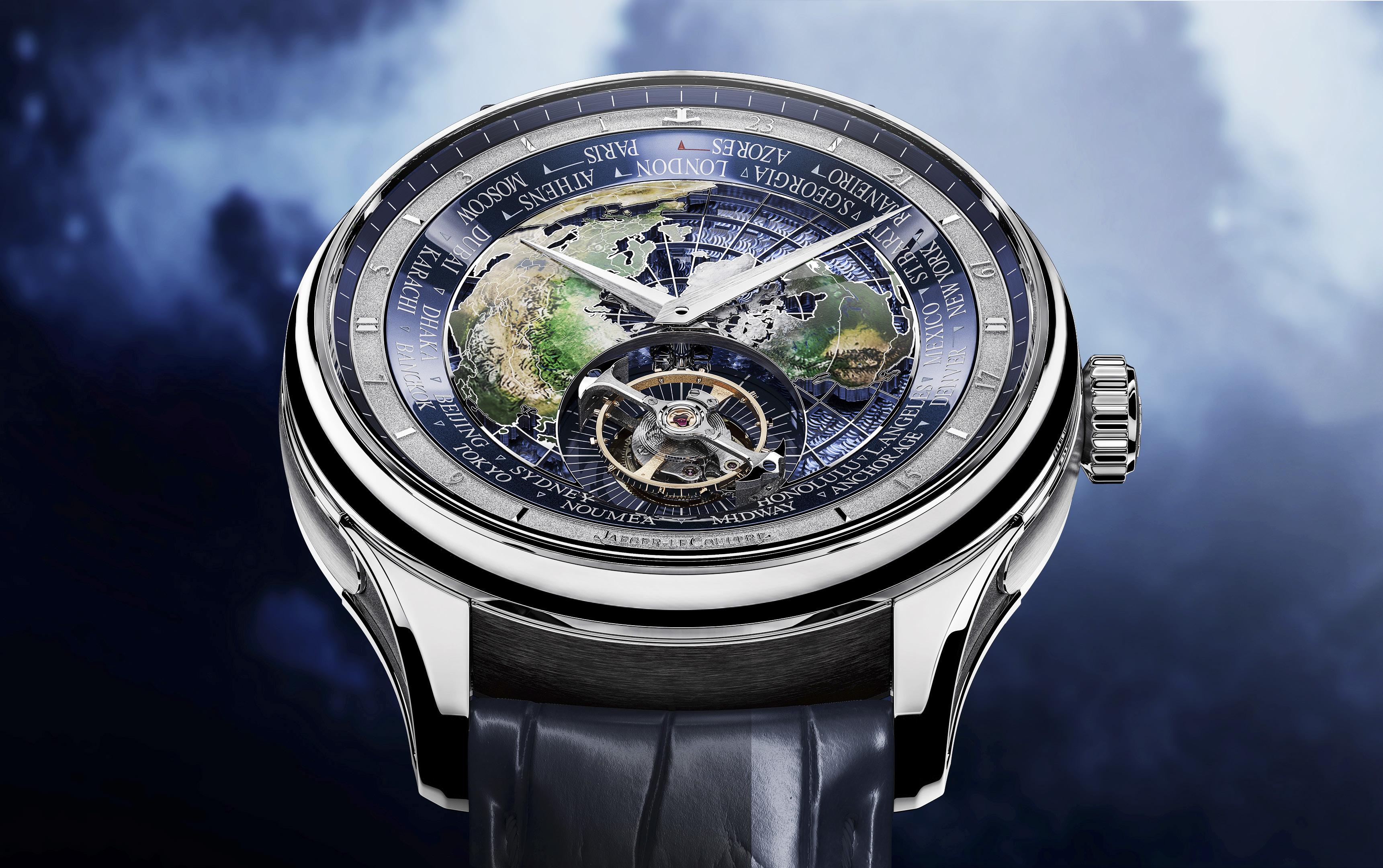
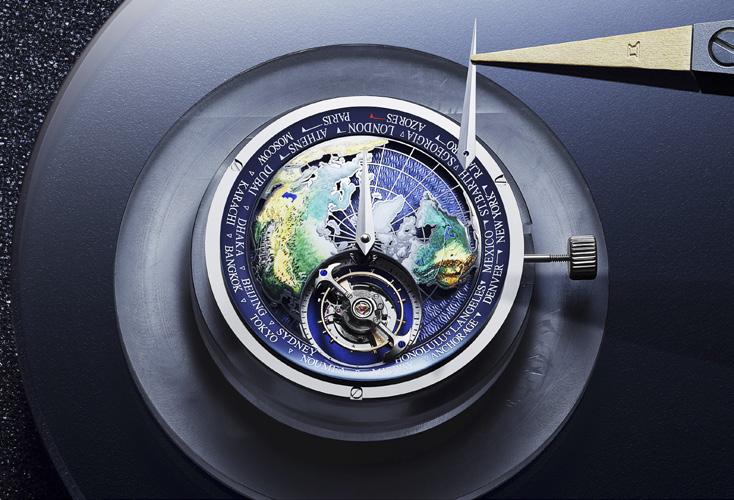
Thus, if you want to know the time in Karachi at any given time of the day, for example, simply locate the city on the rotating city ring and, voilà, the corresponding number on the fixed 24-hour ring is the time in Karachi. The same goes for Athens, New York, Anchorage, or any of the 24 cities on the city ring. Thanks to the calibre 948 the time in every time zone can be determined at a glance at any time of the day without having to push a single button.
Conceived, developed, and produced in its entirely within the hallowed workshops of the Manufacture, Calibre 948 is a true expression
of Jaeger-LeCoultre’s technical expertise, and introduced the world to a world-time complication combined with a flying tourbillon for the first time when it made its bows powering the Geophysic Tourbillon Universal Time in 2017.


It makes its reappearance in the new Master Grande Tradition Calibre 948 slightly modified in 2022 with a new balance wheel; oscillating at a frequency of 28,800; and boasting a power reserve of 48 hours. Best of all, aside from its straightforward and user-friendly world time complication, is also extraordinarily simple to operate. Time is set with the crown, which synchronizes all of the time zones around the world. On arrival at a new destination, local time is set by the same crown, which moves only the hour hand, in one-hour increments forwards or backwards, allowing the minutes and seconds to continue running accurately.
But what truly sets the Master Grande Tradition Calibre 948 apart, however, is the artistry on display by the Manufacture’s Métiers Rares atelier. Just like practically every other world timer in existence (including the Geophysic Tourbillon Universal Time) the dial of the new watch features a map of the world. But what makes this watch distinct is a map as seen from the North Pole at its center, thus allowing the path of the Universal Tourbillon to mimic the rotation of the Earth on its own axis. Further, unlike other "flat" representations, this map floats above the dial bed on a domed skeleton formed by the longitudes and latitudes of the Northern hemisphere. Best of all, the outline of the continents is cut from a sheet of white gold and decorated with champlevé enamel by the master artisans of the Manufacture’s Métiers Rares (Rare Handcrafts) atelier.
Indeed, a noble and ancient enamelling technique that dates back almost 2,500 years ago, champlevé literally translates to ‘raised field,’ and sees the master craftsman first carve out a depression conforming exactly to the outline of the desired image in the raw metal (which in this case are the shapes of the continents as seen from the North Pole). The hollow area is then filled with multiple layers of enamel, each of which is fired at very high temperatures until the whole is flush with the original surface. To this, the details and major landscape features of each continent are painstakingly miniature-painted.
Naturally, beneath the dome is the ocean, which is represented by a disc of vivid blue translucent lacquer rendered in a wavy guilloché pattern to
suggest the movement of the sea, as well as the lunar influence on its tides. Outside of that is the city ring with each time zone represented by the name of a city, while further out from that are two fixed concentric rings: the 24-hour indicator with applied numerals and rectangular indexes, and a minute track laser-engraved on a ring of blue lacquer to match the blue of the oceans. Indeed, the dome alone required some 55 hours of work, while the dial in its entirety required almost 70 hours of work altogether.
A sublime 43mm white gold Master Grande Tradition case makes for a perfect complement to the dial. It is comprised of more than 80 parts,
the different surfaces of which are microblasted, polished and satin-brushed to maximize the play of light. Further, it features a convex bezel that contrasts with the broad bevels of its lugs, while its hollowed-out lug sides add dynamic tension to the mix.
The Master Grande Tradition Calibre 948 is a tantalizing blend of art and mechanics that takes a complication notoriously difficult to manipulate and decipher, and makes it as absurdly simple as telling standard time…all while astounding with tour-de-force mechanics. It is matched with a black alligator leather strap, and is a highly exclusive limited edition of only 20 pieces.
“Thanks to the Calibre 948, the time in every time zone can be determined at a glance at any time of the day without having to push a single button.”


Last year, Panerai announced their partnership with Razer™, a leading global lifestyle brand for gamers, during the 2021 RazerCon held last October. Co-founder and CEO of Razer said: “We have great ambitions around sustainability, but we also know that while there’s plenty we can do, we can’t do it all alone. That’s why collaboration is key for us at Razer, and we are thrilled to partner with Panerai on very important initiatives that will not only benefit consumers, but also the planet.”
Panerai and Razer came together under a shared commitment to advancing ocean preservation. As part of this year-long campaign both brands committed to enhancing ocean literacy.
This year, Panerai is proud to present a watch that merges high-end horology and the iconic aesthetic of the most recognized name in esports and global gaming: The Luminor Quaranta Razer



Special Edition. This special release is limited to 500 pieces and will be exclusively available through Panerai boutiques and Panerai.com.
The colors of the Luminor Quaranta Razer are dominantly black with highlights of electric green on the small seconds dial and the stitchings on the strap. It has a 40 mm case composed of eSteel™ coated with diamond like carbon (DLC). eSteel™ is an alloy that is made from 54.8% recycled steel. Though a majority of its components are recycled, eSteel™ exhibits the same properties as its conventional counterpart. The brushed case has DLC and takes on a matte black finish.
The dominantly black dial displays gray SuperLumiNova™ Arabic numerals and hour markers that glows green to harmonize with the Razer’s distinctive palette. There is a date window at 3 o’clock and the small seconds with the electric green hand at 9. At the six o’clock position is the famous three-headed snake logo of Razer,
executed in a black-on-black rendition. The case is water resistant to 100 meters.
Inside the case is the P.900 calibre that beats at a frequency of 28,800 alternations per hour. It is equipped with the Incabloc™ anti-shock device and has a three-day power reserve. The movement, composed of 171 components, contains 23 jewels and measures 4.2 mm thick.
The case is not the only component that is made of recycled materials. The strap is made from recycled PET derived from post-consumer plastic bottles. It also features a new quick release system that makes it easy for the wearer to change straps to give the watch a new look. Moreover, the watch will be delivered in packaging composed of 72% recycled material. All these recycled materials are a nod to both brands’ commitment toward sustainability.
Panerai and Razer have partnered with Conservation International, the environmental

nonprofit organization, to support marine species research. This research has led to the development of sustainable livelihood opportunities for coastal communities, supported the creation of new protected areas, and informed policy changes that protect these species and their ocean environment.
This initiative is an example of the “Panerai Ocean Conservation Initiative” mission developed in partnership with IOC-UNESCO in the framework of the ocean literacy program of the UN Decade of Ocean Science for Sustainable Development. The “Panerai Ocean Conservation Initiative” is a worldwide educational campaign among 100 universities in the world to enlighten students on how a luxury brand like Panerai can be a force for good for the planet, thanks to its serious commitment towards sustainability and to educate thousands of students on the importance of the ocean.


 Words by Bert Casal
Words by Bert Casal


arlier this year at Watches and Wonders in Geneva, IWC Schaffhausen announced its partnership with Polaris Dawn. Polaris Dawn is a space mission that is set to launch no earlier than March 2023. It will be the first of three spaceflights that will conduct research around the Earth’s orbit. The crew will spend up to five days in orbit. Taking advantage of Falcon 9 and Dragon’s maximum performance, they will attempt to reach the highest orbit any mission has even flown. There, they will be conducting research with the aim of better understanding the effects of spaceflight and space radiation on human health.
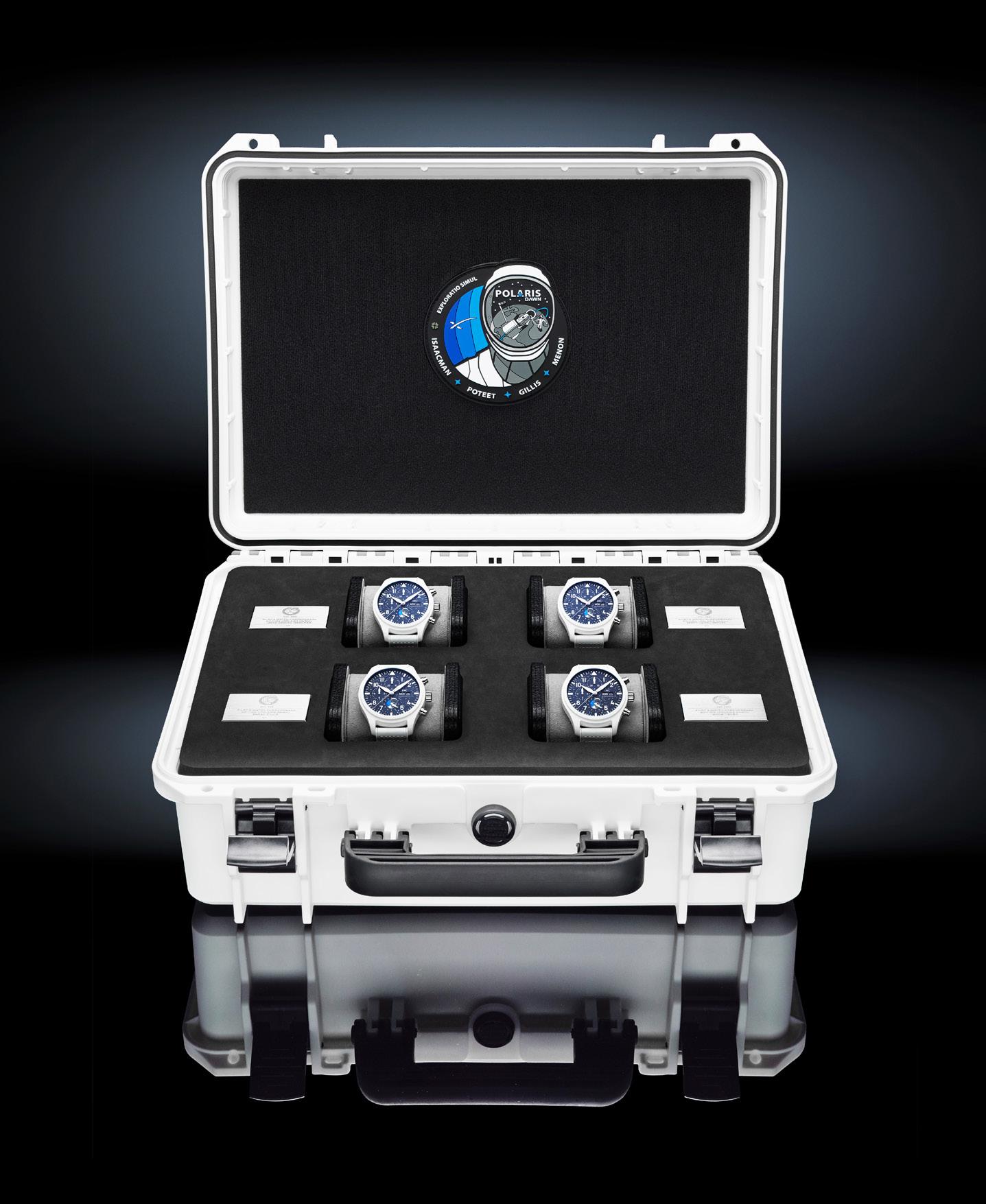
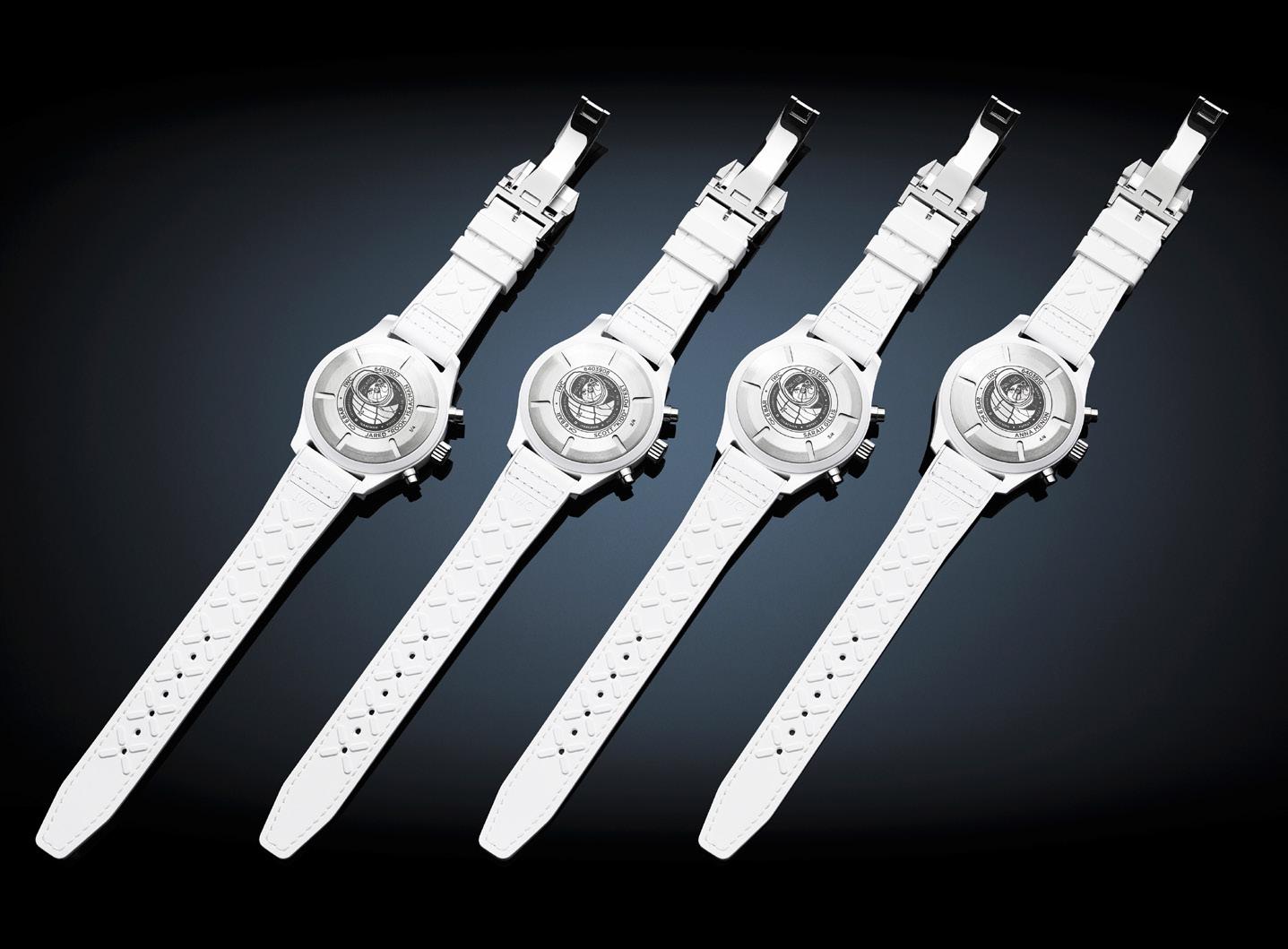
At approximately 700 kilometers above the Earth, the crew will attempt the first-ever commercial extravehicular activity (EVA) with SpaceX-designed suits. This exercise will be important steps towards a scalable design for space suits on future long-duration missions.
While in orbit, the crew will conduct scientific research designed to advance both human health on Earth and our understanding of human health during long-duration space flights in the future. Aside from testing the space suits, they will be using ultrasound to monitor, detect, and quantify venous gas emboli contributing to studies on human prevalence to decompression sickness. They will be gathering data on the radiation environment to better understand how space radiation affects human biological systems. The crew will also be conducting research related to Spaceflight Associated Neuro-Ocular Syndrome (SANS), which is a key risk to human health in long-duration space flight. The Polaris Dawn crew will be the first crew to test Starling laserbased communications in space, providing valuable data for future space communications system necessary for mission to the Moon, Mars, and possibly, beyond.

In addition to conducting research in space, Polaris Dawn will raise funds and awareness for St. Jude Children’s Research Hospital.
In 1962, an American orbited the Earth for the first time. In that same year, a hospital opened in Memphis, Tennessee whose directive was to find cures for kids with cancer and other
life-threatening diseases, regardless of their race, ethnicity, beliefs, or a family’s ability to pay. Treatments invented in this hospital, St. Jude Children’s Research Hospital, helped push the overall childhood cancer survival rate from 20% to more than 80%. However, in many developing countries, fewer than one in five children with debilitating diseases survive. St. Jude is working to change that.
To support this goal, IWC has designed and donated a space-themed chronograph: The Pilot’s Watch Chronograph Edition “Polaris Dawn” (Ref. IW389111) which features a 44.5 mm case made of white ceramic. The bright white color results from a complex manufacturing process in which zirconium oxide is mixed with other


metallic oxides in a precisely defined ratio and then sintered at high temperatures in a kiln. The timepiece features a dark blue lacquered dial printed with countless stars and the mission logo.
The watch will be powered by the IWCmanufactured calibre 69380 automatic mechanical movement with chronograph function for hours, minutes and seconds, a day and date display, small hacking seconds, soft iron inner case for protection against magnetic fields, a screw-in crown, and secured glass against displacement by drops in air pressure. It has a frequency of 28,800 vph and a power reserve of 46 hours. The case will be water resistant to 60 meters.
Four pieces will be produced and given to each of the four crew members of the mission. The
four crew members are Jared Isaacman who will serve as commander, Scott “Kidd” Potent who is a retired United States Air Force Lieutenant Colonel, Sarah Gillis and Anna Menon who are SpaceX and Lead Space Operations Engineers. Each of these crew members will receive the Pilot’s Watch Chronograph Edition “Polaris Dawn” timepiece to be worn during their research in space. Their names will be engraved on the case back of their respective watches.
When the crew returns to Earth, the four chronographs will be auctioned to raise funds for St. Jude Children’s Research Hospital. To be notified of the auction, please visit: https://www. iwc.com/en/specials/polaris-dawn-missionauctionsign-up.html
"THE PILOT'S WATCH CHRONOGRAPH EDITION "POLARIS DAWN" IN WHITE CERAMIC WITH A SPACE-BLUE DIAL WAS DESIGNED TO SUPPORT THE UPCOMING HUMAN SPACEFLIGHT MISSION."


The Superlative Chronometer story continues with a new ‘presidents’ watch’
Words by Kit PayumoAs many Calibre readers already know, the Rolex DayDate is considered to be the ultimate status watch, one that has been worn by more presidents, leaders, political figures, and visionaries than any other timepiece in history. It is a symbol of excellence and prestige that has always been exclusively offered in gold or platinum. And launched in 1956, the brand’s flagship dress model has for years represented the pinnacle of the Rolex art of watchmaking while being built on the three pillars of Rolex.
Indeed, the Oyster Perpetual Day-Date was the first waterproof and self-winding chronometer wristwatch to offer a modern calendar with, in addition to the date, an instantaneous day display spelt out in full in an arc-shaped window at 12 o’clock on the dial, thus giving birth to the name “Day-Date.” This calendar display was conceived and designed by the founder, Hans Wilsdorf, himself and was quite unique at the time of its release.
With this new feature, Wilsdorf designed a no nonsense, albeit, high-prestige Oyster Perpetual timepiece that offered a particularly useful function for people in positions of responsibility: a clear and legible indication of the day and date at a glance; essential information for scheduling, arranging meetings, or signing and dating contracts, which made the Day-Date the perfect watch for world leaders and decision-makers.
The man himself even spoke about his “baby” in a letter a few years earlier saying that in his view the date and the day were the two most useful displays, because they change daily. So Rolex focused on the layout of this essential information, freeing up space on the dial to give them prominence. The result is a 66-year-oldstandard-bearer that speaks for itself.
Furthermore, the Day-Date’s calendar is available in a choice of 26 languages. Yep, for those not in the know, the day of the week can be read in European, Chinese and Arabic languages, including Hebrew. It can also be read in Russian, Greek, Japanese, Indonesian, Scandinavian languages, and even Latin, which (in case you
didn’t know) is still used in the Vatican today. This is the reason that the Day-Date has, for the longest time, been the go-to watch for heads of state, dignitaries, and leaders from all corners of the globe. Indeed, it was the first wristwatch to literally “speak” in their language and they probably felt their Rolex was especially made just for them.
Naturally, being a Rolex, the Day-Date is renowned for its exceptional precision and reliability, qualities that have endeared this model to an entire gamut of watch enthusiasts. The words “Superlative Chronometer Officially Certified” on the dial has for years proudly pronounced the exceptional precision of its beating heart, which according to Rolex was made to perform
even “better” than an “ordinary” chronometer by garnering “particularly good results” after its official tests back in the late 50s. In fact, back in 1956 the Day-Date was one of the first models to carry this Rolex-signature certification.
For 2022, Rolex has updated the top-of-thefood-chain 950 platinum model of the Oyster Perpetual Day-Date 40 and the watchmaker has included some interesting changes. Until now, platinum versions of the watch featured smooth bezels. This year, Hans Wilsdorf’s company has shaken things up with a fluted bezel that the watchmaker has thrown into the mix. For those not in the know, Rolex fluted bezels have traditionally only been used with 18K gold models. Not anymore. This year, the new Oyster Perpetual


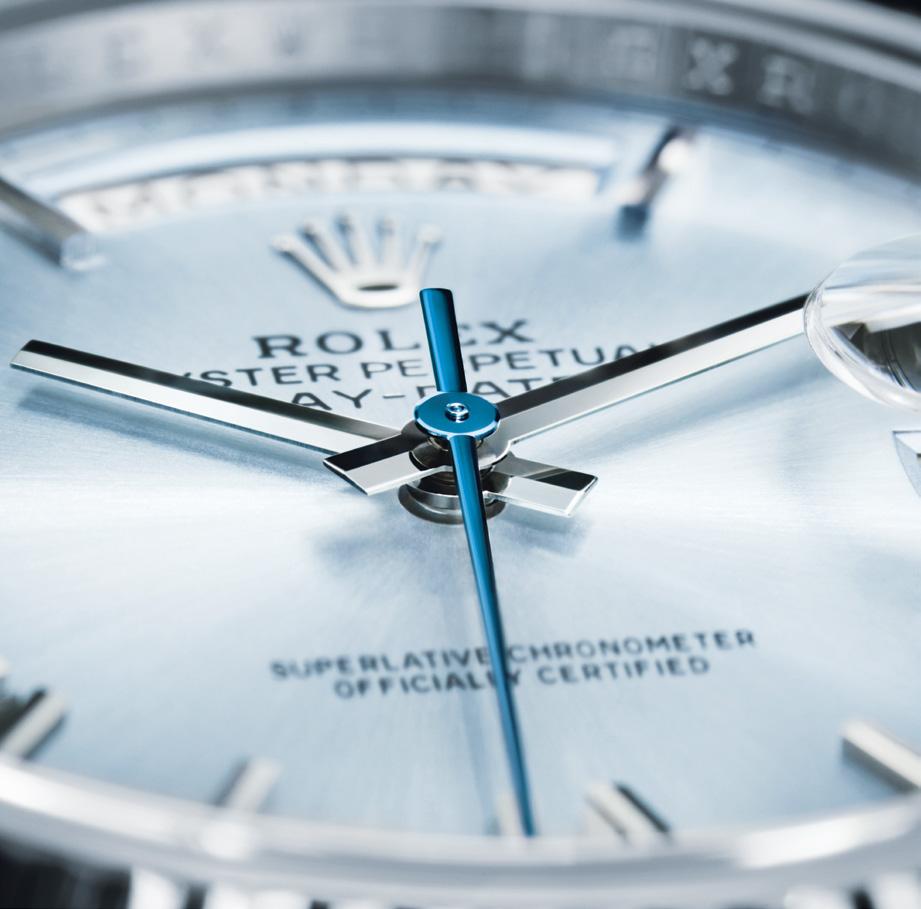

Day-Date 40 in 950 platinum is also being offered with a fluted bezel, but this particular upgrade came with its own set of problems.
While its true that platinum is known for its exceptional luminosity and its captivating white glow that is unlike white gold, the material is, however, notoriously difficult to work with, and let’s not even talk about its finishing. So why even make the attempt? Because, is the answer. So, Rolex (being Rolex) had to come up with a new manufacturing process to manipulate the material into a fluted bezel that fit their requirements. Indeed, producing fluting in the required shape and finishing was a technical feat that only a top-tier watchmaker like Rolex could have realized.
Further, this new platinum edition also comes with the same ice-blue dial that are exclusive to all platinum Rolexes but this time eschews the busy diagonal motif that marked the previous model. Instead the new dial gets a “regular” sunburst finish that somehow makes it look even more premium than anything that’s come before. Otherwise, nothing else has changed for this Superlative Chronometer.
And that includes its powertrain. Once more pulling power duties for the new Oyster Perpetual Day-Date 40 in 950 platinum is the calibre 3255, the latest generation of Rolex mechanical calibre that surpasses the levels established by the modern COSC in defining chronometer accuracy. It boasts 14 Rolex patents and showcases several
improvements over its predecessor the Rolex 3156 calibre that powered the Day-Date II
Indeed, over 90 percent of the movement parts have been redesigned and optimized including the new Chronergy escapement made of nickelphosphorus. Patented by Rolex, it combines high-energy efficiency with great dependability and is also insensitive to magnetic interference. The oscillator, the true heart of the watch, has an optimized blue Parachrom hairspring. Patented and manufactured by Rolex in an exclusive paramagnetic alloy, it boasts up to 10 times more precision than a traditional hairspring in the event of shocks. And thanks to a new barrel architecture and the escapement’s superior efficiency, the power reserve of calibre 3255 has been extended to 70 hours.
All this translates to the 3255’s remarkable -2 to +2 seconds per day “Superlative” accuracy. This was achieved by the manufacture’s own rigorous in-house tests of the fully assembled watches AFTER the COSC ALREADY tested and certified the uncased movements. This ensures that the Day-Date passes the Rolex criteria of precision in everyday use, which is twice as exacting as those of an officially certified chronometer.
That tried-and-true symbol of waterproofness also makes its prerequisite appearance. Providing optimum protection for the watch’s movement, the 40mm Oyster case is guaranteed waterproof to a depth of 100 meters (330 feet), and is crafted from a solid block of 950 platinum. Its case back, also edged with fine fluting, is hermetically screwed down with a special tool, while its Twinlock winding crown, also fitted with a double waterproofness system, screws down securely against the case. Further, the crystal fitted with the signature Cyclops lens at 3 o’clock for easy reading of the date, is made of virtually scratchproof sapphire and benefits from an antireflective coating.
Naturally, this latest version of the Day-Date 40 is also fitted with the brand’s signature President bracelet, a three-piece link affair created specially for the launch of the prestigious Oyster Perpetual Day-Date way back in 1956. Indeed, this DayDate signature differentiates it from less-expensive Datejust models. This latest version, however, includes an elegant concealed folding Crownclasp with ceramic inserts built into the links to enhance flexibility and longevity. Not to mention, a concealed attachment system is also on hand to ensure a seamless visual continuity between the bracelet and case, making the new Oyster Perpetual Day-Date 40 in 950 platinum with ice-blue dial the ultimate Rolex dress watch.

“The Rolex Day-Date is considered to be the ultimate status watch, one that has been worn by more presidents, leaders, political figures, and visionaries than any other timepiece in history.”

The maker of the moon watch is ready for the next giant leap for mankind
Words by Kit Payumo
Made in partnership with the European Space Agency (ESA), the Omega Speedmaster X-33 Marstimer is everything the name suggests, and (believe it or not) is ready to take on the challenge of a Mars mission today if any space agency comes calling tomorrow.




Indeed, for Omega President and CEO Raynald Aeschlimann, producing the Marstimer was a must for a watchmaker with space travel in its bones. “Anyone interested in space, or even science fiction, is obsessed with Mars. It has generated so much curiosity, so many incredible stories.We have
even created a name for its imaginary inhabitants. It’s so close yet so far.We long to walk across its surface. To be here on Earth and able to track its movements, gives the term timepiece a whole new meaning. I’m thrilled with this new addition to the famous Speedmaster family.”
Part of the Speedmaster Professional X-33 line, which was first introduced in 1998 as the “Mars Watch” (yes, they already called it that back then) and certified by NASA to update and supplement the original Speedmaster Professional still in use by the space agency since the Gemini program, the Omega Speedmaster X-33 Marstimer is a new digital and analog hybrid timepiece that takes all the advancements made by the equally

ESA-tested and qualified Omega Speedmaster X-33 Skywalker and runs with it. This includes MET (Mission Elapsed Time), and PET (Phase Elapsed Time).
The original Speedmaster Professional X-33 also had a particularly long chronograph function capable of measuring days, hours, minutes and seconds, and was useful in timing an entire mission or flight. It could also display UTC time indicating the day of the week, the hour, minutes, and the seconds, and was fundamental for time measuring devices of this kind to compensate for timezone changes. The original watch also had an 80db alarm function, a chronograph capable of measuring 1/100 of a second, and a backlight
“The Omega
X-33
is ready to take on the challenge of a Mars mission today if any space agency comes calling tomorrow.”
function operated by a pusher that made the display light up in the dark.
Indeed, the new Speedmaster X-33 Marstimer takes all that and ups the ante by being designed with additional Martian requirements in mind.
Premier of which is an MTC (Mars time Coordinated) function, which was developed under an ESA patented license that takes into account the fact that a day on Mars is 39 minutes longer than on Earth and tracks the Red Planet’s sol date and time at the prime meridian. This distinguishes the difference between Mars and Earth times, and allows for the easier communication with Mission Control on Earth.
But that’s not all. This unique 45mm chronograph encased in grade 2 titanium was
specially developed to assist scientists of all kinds and specifically offers a range of valuable tools for those working in the field of space research. And powered by Omega’s 5622 Calibre, a highly precise, thermo-compensated quartz movement, which is more than up to the task of handling the Marstimer’s myriad of digital and analogue functions with speed and efficiency, the newest member of the X-33 line is also equipped with an innovative solar compass, which can point to true north on both the planet Earth and on Mars.
Naturally, a watch geared for all things Martian should also look the part, all while keeping things familiar in accordance with its original mission. Thus, the Speedmaster X-33 Marstimer features a classic black dial, which provides a contrasting
backdrop for the multiple analogue and digital readings made even clearer by Earth and Mars symbols to distinguish which particular functions are in use. And while a unidirectional bezel was always part of the X-33’s list of standard equipment, new for this particular mission is an oxalic anodized aluminum bezel ring, the color of which is red hematite, a color reminiscent of the Red Planet’s distinctive dust.
And this is why we feel this X-33 is really just a taste of things to come because coloring something as functional as a unidirectional bezel in the same color as a planet’s dust seems a bit counter intuitive, and definitely counter to actual functionality.
This never-the-less attractive color is echoed on the seconds hand on the dial, which features a black to red hematite gradient, a design code that signals this timepiece’s status as an Omega professional instrument. While the grade 2 and 5 bracelet and caseback on this Marstimer are virtually identical as with the previous X-33 model.
The former however, can be swapped with a dedicated NATO strap with a strap changing tool, both of which come with the package; while the latter features Omega’s famous Speedmaster wording and Seahorse logo embossed at its center and circled by the words SPEEDMASTER X-33 MARSTIMER, ESA TESTED AND QUALIFIED.
Out of the box, the new watch also comes with a special watch roll (for easy transport) that features a rendering of Hebes Chasma, an enclosed, almost 8000-meter deep trough in the northern most section of Valles Marineris, the 3000-kilometer long “Grand Canyon of Mars.”



Interestingly, the Speedmaster X-33 Marstimer is available for purchase by anyone. But why anyone would need to tell what the solar time on Mars is, we suppose, anyone’s guess. Indeed, this X-33 is choc-full of functions most Earth-bound explorers (read: couch sitters) will most likely never use. This makes this latest in the X-33 line as much the most practical modern Speedmaster ever made as it is the most impractical one.
But even if not a single member of the Calibre team is even remotely qualified to work with ESA or NASA, or necessitate the need to use such a timepiece it doesn’t take away from how cool everything about the Speedmaster X-33 Marstimer actually is, and that includes the fact that the European Space Agency was involved in its development.
 Words by Katherine Cunanan
Words by Katherine Cunanan
Man has always been fascinated with the skies and flight. Looking to the sky allows you to dream of what could be, of what you might see, and of what you might achieve. Even today when you ask young children, and the young at heart, which superpower they would want to have, the ability to fly is one of the most popular. The power of flight would give you freedom to move around, and afford you a new perspective. Not to mention make you the envy of mere mortals who would sadly be earth-bound. You could be flying away from something, or flying to someone. Your journey, and not the destination, could even be your primary goal.

This fascination with freedom and flight found its way to the famed Hermès scarves back in 1984. Loïc Dubigeon was a French artist, sculptor, and muralist. He was trained as an architecture at the Arts et Métiers de Paris. It is not surprising that the structure of architecture as an art form perhaps led him to the beauty of other art forms, ones that afforded a little more freedom of expression. He has created several designs for Hermès scarves involving different architectural forms, but also precious images of teddy bears, for example. Such range this artist had. Loïc Dubigeon’s interpretation of les folies du ciel, or follies of the sky, as a silk scarf motif was fantastic. The dreams and visions were interpreted in such a dreamy and fanciful way that it just made the desire for flight more real.
The Les folies du ciel scarf features hot air balloons, airships, and other flying vessels. Taking a closer look at the scarf design will reveal small drawings of people on some of the flying machines. You can practically feel the excitement and adrenalin of the characters, seeing new sites for the first time, looking out at the horizon from a different height. If you’re interested in a beautiful silk scarf to match your watch, there is a double-face version with hand-rolled edges that is simply to die for.

This wonderful flight of fancy expressed so well on a scarf then made its way onto a watch. Not just any watch, mind you, but the Hermès Arceau watch. The Arceau is a clean, classic watch that has had different models over the years, sometimes in stainless steel, sometimes in white gold. The clean aesthetic of the Arceau allows it to have different enhancements added to it without overwhelming the whole look.
The Hermès ARCEAU Les folies du ciel watch carries the artistic interpretation of the Loïc Dubigeon design onto the dial of the Arceau watch. The 38 mm white gold case pairs well with the mother-of-pearl dial. Mother-of-pearl is the iridescent, milky interior shell of the fresh water mollusk. Each mollusk is different, so each piece of mother-of-pearl is unique. The creamy white color of the dial here adds to the dreamy essence of the watch, and allows the rest of the artwork to take center stage.

“...it just made the desire for flight more real.”
Speaking of center stage, a white bird-shaped gondola takes pride of place just above the 6 o’clock space. The bird is, of course, the initial inspiration for flight. The hand-painted bird in yellow and pink with touches of green is playful. The gondola has 2 hot air balloons, in pink and green neoralite, and three green chimneys in the center. Peeking out from behind the green chimneys are thin gray wisps of smoke, also in mother-of-pearl, that make it seem like the gondola is mid-journey. The tiny people are seen on the watch dial too. I can just imagine their anticipation. Where are they heading to? To new lands of interesting sights and experiences, we’d like to think. Take us with you, we whisper.

The whimsy doesn’t end there though. At the 12 o’clock spot is another balloon, but this one actually moves. It spins on its axis as your wrist moves too. Also seen at the 12 o’clock spot is the

embossed Hermès Paris sign. Each surface on the Hermès ARCEAU Les folies du ciel watch is artistically done and highly polished to bring the flights of fancy to life.
The Hermès ARCEAU Les folies du ciel watch has a mechanical self-winding movement, the Manufacture Hermès H1837 movement. The movement measures 25.6 mm in diameter and 3.83 mm in thickness. It has the hours and minutes functions, and really, that’s all you need.
The round white gold case creates the perfect frame of the delicate artwork on the dial. The alligator leather strap is Chantilly is gentle partner to the watch, keeping the focus on the dial itself. The Hermès ARCEAU Les folies du ciel watch is a numbered limited edition of just 24 pieces. Take the watch and imagine your next journey.

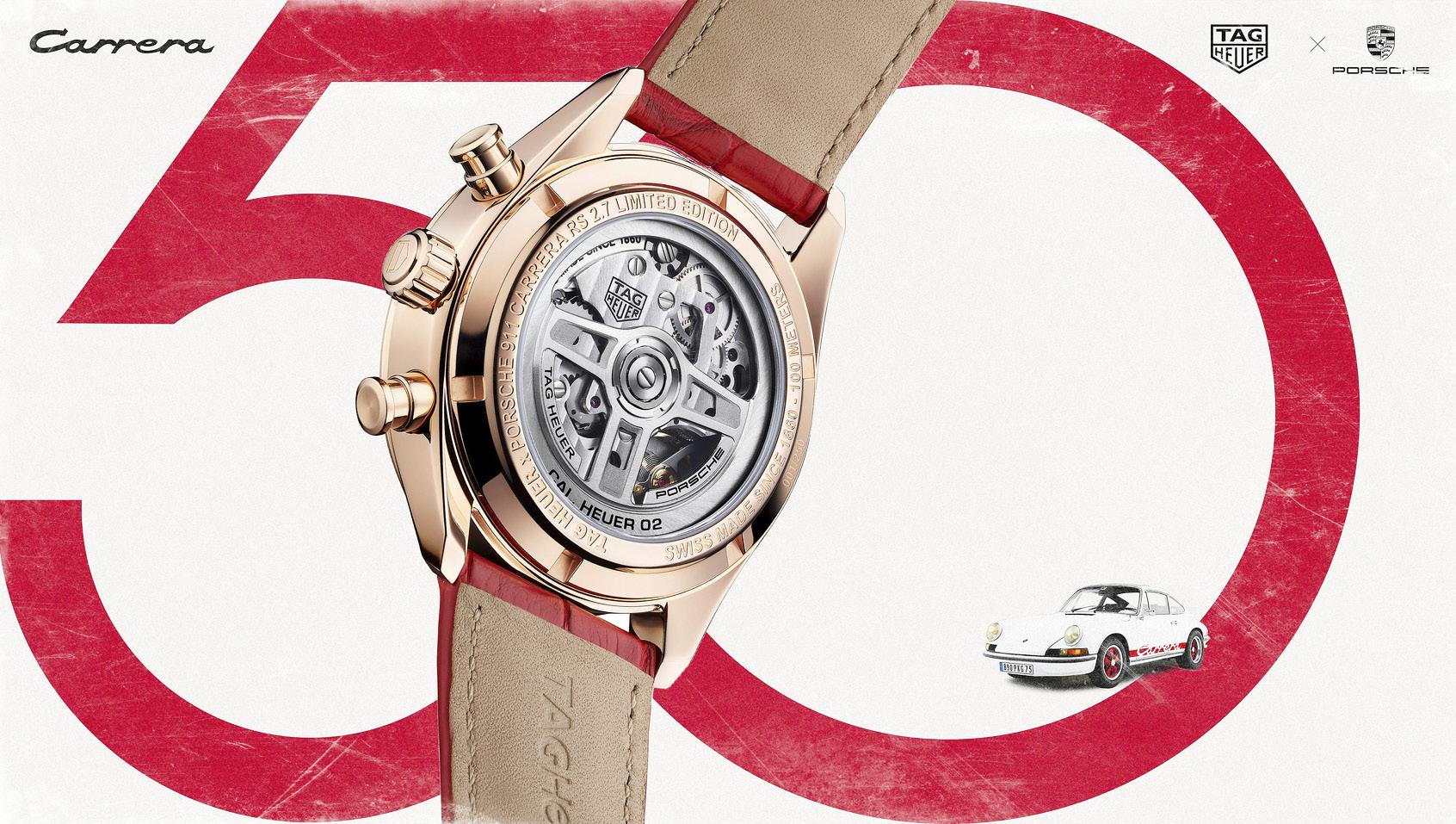 Words by Bert Casal
Words by Bert Casal
Legend has it that Jack Heuer competed in the famed Carrera Panamericana race at one time. He was in the lead of the pack but dropped it because he couldn’t read the dashboard timer correctly. Infuriated by his loss, he set out to design and improve the readability of the timer. But he didn’t stop there. He then went on to design a wristwatch for racing drivers that was incredibly legible. He released this watch in 1963 and called it the “Carrera” in honor of the Carrera Panamericana race.
His new Carrera line focused on typography for better legibility. Its design language was so clear and minimal, the wearer could focus on reading the time with incredible ease with no chance of confusion. And from then on, the TAG Heuer Carrera collection has become the ultimate showcase for the brand’s fascinating
motor racing heritage. Its timeless, sporty, and elegant designs have been a benchmark for motor racing timepieces.
The Porsche 911 was originally set to be sold as the 901. Peugeot contested this and claimed the rights to three-digit car names with a zero in the middle. So, the Porsche 901 was renamed to the Porsche 911 Carrera RS 2.7 and was revealed on October 5, 1972 at the Paris Motor Show.

The Porsche 911 Carrera RS 2.7, during its day, was the fastest German production car of its day and the most powerful 911 available for use on the street. It was lightweight. It was aerodynamic. It was the first road car in the world to have a front and rear spoiler which improved driving stability and a higher top speed. It was a road vehicle that was intended for owners to take part in racing events.
In February of 2021, TAG Heuer and Porsche entered into a global partnership. Although this
is the companies’ first joint product production, they have collaborated many times in the past. This partnership celebrates the brands’ shared history and values. On this fourth installment of their collaborative design, TAG Heuer releases two new limited edition timepieces in tribute to one of Porsche’s most iconic models: the Porsche 911 Carrera RS 2.7, which is celebrating its 50th anniversary this year.
To mark this occasion, two distinctive TAG Heuer Carrera x Porsche Limited Editions are being introduced, showcasing the signature features of the 1972 sports car and the 1963 chronograph.
The Porsche 911 Carrera RS 2.7 was produced in a range of 27 vivid colors, two of which were selected for the TAG Heuer tribute watches: the blue and the red colors that spelled out the Carrera logo as well as the solid line down the side, set against the white body of the car.
"TAG HEUER AND PORSCHE CELEBRATE THE CARRERA NAME WITH TWO NEW LIMITED EDITION TIMEPIECES."
The blue edition is limited to 500 pieces, marked by XXX/500. The finely polished steel case, rhodium-plated indexes and hours and minute hands recall the car’s chrome door handles, mirrors and window frames. The dial is made of smooth white opaline, while the two subcounters feature an eye-catching “azurage” finish. Porsche’s design codes are seamlessly integrated throughout the TAG Heuer piece, with its blue lacquered push buttons and shield logo on the crown, and blue markings on the Calibre Heuer 02 oscillating mass. The right sub-counter design recalls the rims’ aesthetic, while the signature color stripe and Carrera logo make a bold statement on the dial, flange, case side, and strap. This timepiece is presented with both a sporty fabric strap with the Porsche logo and Carrera markings, as well as an elegant steel bracelet with ergonimic H-shaped links for more formal occasions.



The red edition is limited to only 250 pieces, marked XXX/250. The refined case is in 18K 5N rose gold, as are the crown, pushers, and screwdown sapphire case back. The white dial is framed with a Guards Red circular line and features rose gold-colored applied indexes, permanent second indicator, and hour and minute hands.

These two collectors’ timepieces are each presented in specially designed, co-branded TAG Heuer x Porsche packaging with vibrantly colored inserts.
Frédéric Arnault, CEO of TAG Heuer said: “The name and spirit of the Carrera are incredibly meaningful and emblematic for both TAG Heuer and Porsche. So for the 50th anniversary of the very first Porsche 911 Carrera, the iconic RS 2.7, we wanted to create a tribute watch that would express the character and power of this ground-breaking sports car within our own signature TAG Heuer Carrera chronograph. The two timepieces we imagine together are sleek, assertive, memorable. They reflect their illustrious past while also projecting something even more exciting — what Porsche and TAG Heuer can now achieve together.”
TAG Heuer and Porsche have created the ultimate expression of their shared Carrera racing spirit. These two bold timepieces expertly mix the most beloved and recognizable codes from both brands and will delight collectors and fans of the special blend of performance and style that TAG Heuer and Porsche both represent.


Glashütte Original impresses with their first diver’s watch equipped with a chronograph movement
 Words by Kit Payumo
Words by Kit Payumo
hen Glashütte Original (GO) started the Spezialist line of sport watches just a few years ago it marked an abrupt divergence from the more elegant and dressier timepieces that the brand was known for. Indeed, before that nary a single rotating bezel was to be found in any GO collection but the emergence of the first SeaQ models that launched the line marked the end of that. These initial SeaQ models were fairly straightforward in their execution: a traditional three-hand dive watch and a more exclusive (read: more expensive) model that threw GO’s signature Panorama Date into the mix.
This year, the latest SeaQ diver’s watch shakes all that up to become a quasi-hybrid diver’s chronograph, and a flyback at that. This means the new SeaQ Chronograph not only sports GO’s signature Panorama Date, but also throws in a flyback chronograph for good measure. And just like the rest of the SeaQ models this diver’s chronograph boasts up to an impressive 300 meters of water resistance (and that’s with Chronograph pushers), which once again certifies it to ISO 6425 and DIN 8306 standards of sport and dive watch functionality.
To be fair, while a watch that combines a dive bezel with a chronograph is no longer anything to write home about there’s simply something about a steadfastly traditional watchmaker not exactly known for making tool watches executing a resolutely sporty timepiece of this


calibre. Glashütte Original cannot get any more traditional. And it’s all due to the entirely inhouse, self-winding Calibre 37-23.
The epitome of the exceptional in-house, integrated column-wheel flyback chronograph, the Calibre 37-23 is undoubtedly impressive especially considering that the incorporation of a flyback chronograph did not compromise its impressive 300m of water resistance. A variant of the Manufacture’s Calibre 37 chronograph movement that debuted in 2014, the Calibre 37-23 has benefitted from some significant updates, premier of which is shock resistance. Indeed, not only can the 43.2mm stainless steel case withstand a drop from a height of one meter, but the GO watchmakers went the extra mile to design a hexagonal socket screw over the
hand shafts and underneath the central pinion to affix the dial to the plate before the hands are mounted. This protects the dial from buckling or warping from pressure or impact.

The aforementioned large Panorama Date sits on two concentrically mounted wheels on a single plane. And to enhance user-friendliness, pulling the crown to position 1 winds the automatic movement, position 2 corrects the date, and position 3 sets the time while stopping the seconds hand. This means the date corrector on the side of the case that may compromise water resistance has been removed.
Further, Calibre 37-23 also shrugs off magnetism with a silicon hairspring and boasts up to 70 hours of power reserve despite oscillating at 28,800 vibrations an hour or 4Hz. Naturally, the
movement is elaborately decorated by hand and includes Glashütte striping on both the threequarter plate and skeletonized oscillating weight with a solid gold mass and double-G logo, and a swan neck regulator, all of which is in glorious display via the sapphire caseback.
Which brings us to how the new SeaQ looks. From the get-go the Spezialist line was designed to take advantage of GO’s storied history, and was promised to draw on sporty, vintage designs from the 1960s, 50s, and even earlier. This means the GO watchmakers wouldn’t shy away from taking inspiration from watches created by the brand’s historically fascist predecessor, the Glashütte Uhrenbetriebe, or GUB, the state-run East German watch conglomerate founded in 1949 that forcibly pooled all the watchmaking companies in the

region together. The SeaQ series of watches made good on that promise. Especially today.
Indeed, Glashütte Original has practically the entire history of German watchmaking at its disposal and the new SeaQ Chronograph is evidence of that. Just take a gander at that broad arrow minute hand, the stubby hour hand, and the hour markers (especially the open ‘6’), these are taken directly from the 1969 Spezimatic Type RP TS 200 that directly inspired the SeaQ diver. Further, the rhodium-plated applied hour markers and handset both feature SuperLumiNova, while two stepped subdials boast the running seconds at 9 o’clock and a 30-minute chronograph counter at 3 o’clock.
Of particular note is the inclusion of the lumed lollipop hand on the running seconds, which

allowed the SeaQ Chronograph to meet the ISO 6425 and DIN 8306 requirements for proper dive watches. The flyback chronograph hand features a GO logo counterweight and is polished to match the hands, while the large Panorama Date moves from its 4 o’clock position on the original model to 6 o’clock, which not only prevents it from encroaching upon the subdials, but also makes for a symmetrical and balanced dial.
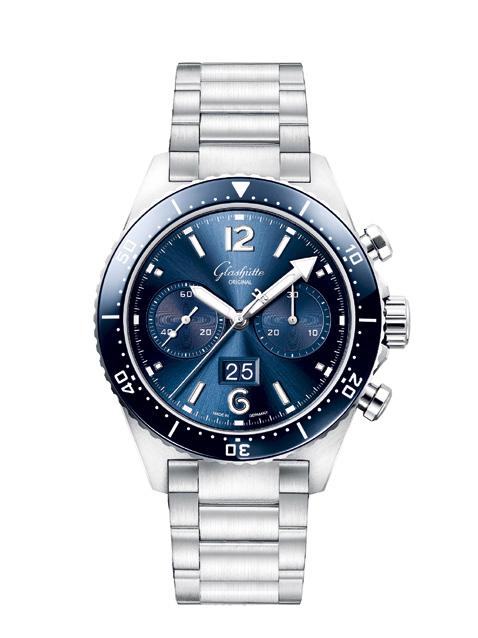



Speaking of which, the PVD blue dial with sunburst finish of the new SeaQ Chronograph once again benefits from the fact that Glashütte Original has its own in-house dial manufacture. This brilliant hue is echoed on the ceramic insert of the unidirectional bezel with a 60-minute diving scale to match the dial. The case features the same integrated lugs with sharp, taut angles, and the circular-brushed surface of the original, while the fluted and polished screw-down crown is protected by discreet crown guards and flanked by pump-style pushers. These, as well as domed box-type sapphire crystals on both sides further punctuate that vintage aesthetic. Alas, this had the undesired effect of increasing the overall thickness of the watch, and at 16.96mm thick the SeaQ Chronograph seems to have been designed for all but the most robust of wrists in mind.
The Glashütte Original SeaQ Chronograph is matched with a classic stainless steel link bracelet but can also be had with an optional dark blue rubber strap, or a choice of either high-quality grey or blue synthetic fabric straps made from recycled fishnets.
“There’s something about a steadfastly traditional watchmaker not exactly known for making tool watches executing a resolutely sporty timepiece of this calibre.”SeaQ Chronograph

Oris equips their historic diver’s watch with two game-changing updates
 Words by Kit Payumo
Words by Kit Payumo
Oris released their first in-house movement in 2020, and it’s been making waves (pardon the pun) ever since. Called the “new standard” in automatic movements by Oris’ CoCEO Rolf Studer, the Calibre 400 indeed became “standard” equipment for many of Oris’ premier offerings. But in the two years since its launch, the independent brand has all but been rushing to get their newly minted movement into as many of its “regular” product lines as possible. Which is why it was curious that it took this long for the Calibre 400 to find its way into a regular-production variant of the brand’s ever-popular Divers Sixty-Five series of vintage-style dive watches. Fortunately, we believe it was worth the wait.

The new Divers Sixty-Five 12H Calibre 400, which was part of Oris’ novelties for Geneva Watch Days 2022, is as classic/contemporary as they come, and sports a clean monochrome aesthetic that complements its more than half a century of Oris watch design. Indeed, the first


Divers Sixty-Five was introduced in 1965 (hence the name) and the new watch avoids the “vintage” design trap by sticking with the basics but in a refined, contemporary way.
This was done primarily by being monochromatic, premier of which is a simple matte black dial enhanced by modern applied silver indices with white Super-LumiNova inserts. The same goes for the line’s signature sword hour and minute hands and the lollipop seconds hand. Of particular note is the instantaneous date display at 6 o’clock. Many prefer their diver’s watches without the distraction of a date window but this one has a dial matching white on black color scheme that allows it to blend into its surroundings. Indeed, the softly rounded cutout window is small enough and the type of Roman numeral used is subtle enough for the whole affair to be quite unobtrusive.
But we digress. The real news here is the in-house Calibre 400, which replaces the Sellita SW200-1 (Calibre 733) and brings with it a whole slew of upgrades. For starters, the new movement boasts 24 jewels and beats at 28,800vph. Despite
“The new watch avoids the “vintage” design trap by sticking with the basics but in a refined, contemporary way.”
the higher energy requirement, Calibre 400 still boasts up to 120 hours or 5 days of autonomy, a significant bump up from the Sellita’s 38-hour power reserve. The new movement also brings elevated levels of anti-magnetism, and in fact, exceeds the ISO 764 anti-magnetic standard with more than 30 anti-magnetic components including a silicon escapement. Accuracy is also within COSC specifications, while a 10-year warranty with a 10-year recommended service interval comes standard for any Oris powered by the Calibre 400. The well-finished but relatively undecorated movement can be viewed from the caseback, which brings its focus on performance and value to the fore.
The very modern size of 40mm also adds to the classic but contemporary vibe of the watch,

all while following the aesthetics established by the rest of the Divers Sixty-Five family. This includes the long unchamfered tapering lugs, the skin diver-style unguarded pillbox crown, and narrow coin edge bezel, all of which are present and accounted for here. But as we mentioned the new watch sports two game-changing updates, the second of which comes in the form of a new 12-hour bi-directional rotating bezel, which, curiously was designed to serve as a second time zone and not a diver’s bezel. But considering this new watch is water-resistant to “only” 100 meters, perhaps the omission was appropriate, not to mention the change effectively sets this new model apart from its non-Calibre 400 brethren.
Further, a domed sapphire crystal with an anti-reflective coating in its interior protects
the dial, while a sapphire exhibition caseback displays the in-house automatic movement, neither of which add to the height of the watch either visually or actually. Indeed, this new Oris feels like something 10mm thick but is actually 12.8mm, the perceived thinness of which adds to the feeling that Oris was moving away from the typical dive watch aesthetic, at least with this particular Divers Sixty-Five.
Last but not least the new Divers Sixty-Five 12H Calibre 400 is part of the regular collection and is not a limited edition. It can be had with a black leather strap with a stainless steel buckle or an optional multi-piece stainless steel bracelet flourished with designer rivets on its side links, which seems intentionally vintage “inspired” in its styling.


Breitling was founded in 1884.
This Swiss watchmaker company invented the modern chronograph and pioneered the navigational tool watch. Breitling’s collections center around air, land, and sea pursuits. The exceptional quality of every watch movement is confirmed by its status as a COSCcertified chronometer.
In the 1960s, while watch brands were vying for positions in automobile racing, Breitling was the undisputed pilot’s watch, but the world’s attention was slowly shifting beyond the air and rapidly advancing towards space exploration. And thus, the race between watchmakers was on, to see which brand would have the title of the “first watch in space.”
Breitling’s expertise in aviation watches shot the brand to the head of the pack. On May 24, 1962, Breitling officially claimed the title “first Swiss wristwatch in space” after astronaut Scott Carpenter orbited the Earth three times while wearing the Navitimer Cosmonaute during his Mercury-Atlas 7 mission. The watch had been Carpenter’s personal request, a variation of the iconic aviator’s watch he’d encountered in his flight days, but with a 24-hour dial to tell night from day, a useful feature especially in space.
Five hours after launch, the Aurora 7 space capsule, with Carpenter aboard, splashed down safely in the Atlantic. The recovery operation lasted three hours. The long exposure to seawater resulted in irreparable damage to Carpenter’s Cosmonaute. Breitling immediately replaced the watch, but that battered and corroded piece of



space history remained in the Breitling family archives, unrestored. Until today.

Now, exactly 60 years after its historic flight, the first Swiss wristwatch to reach space is exhibited for the first time to select collectors, journalists, and watch enthusiasts at a space-themed event in Zurich. The event was hosted by George Kern and former NASA astronaut Scott Kelley.
Today, on the 60th anniversary of that mission, Breitling unveils a modern tribute to the original Cosmonaute worn by Carpenter. This special release is limited to just 362 pieces, in reference to the number of orbits Carpenter took and the year it was accomplished.
The Cosmonaute is a true Navitimer, meaning it has all the hallmarks of Breitling’s aviation icon: the circular slide rule for performing mathematical calculations, the Aircraft Owners and Pilots Association “wings” logo, and the trio of chronograph sundials. The new Cosmonaute is a faithful reproduction of the original, made timeless with an all-black dial and black alligator strap, or seven-row stainless steel bracelet.
The 41 mm stainless steel watch has a platinum bezel. It is water resistant to 30 meters, protecting the COSC-certified Breitling Manufacture Caliber B02, a mechanical handwound movement that beats at 28,800 a/h. This mechanism can be seen through the case’s sapphire crystal caseback. A special bridge with engravings marks the occasion with the words: “Carpenter,” “Aurora 7,” and “3 orbits around the Earth.”
The Breitling Navitimer B02 Chronograph 41 Cosmonaute Limited Edition takes us back to the origins of space travel. When the race was on, the stakes were high, and every mission was a triumph of human ingenuity. This new watch honors the aesthetics of the original Cosmonaute, with subtle updates that work almost imperceptibly to give its modern-retro appeal. As a final tribute, the caseback is engraved with he date of Carpenter’s mission,”ONE OF 362” and the phrase “First Swiss wristwatch in space.”
What separates the Cosmonaute from the rest of its family is its ability to tell 24-hour time. The Breitling Manufacture Caliber B02 was specifically designed for this task.
⊳ Historical Breitling Navitimer Cosmonaute from 1962 and the original Navitimer Cosmonaute/ first Swiss wristwatch in space worn by Scott Carpenter during his Mercury-Atlas 7 mission in 1962



The Bvlgari Octo watch was introduced in 2012, and is a combination of both Italian style and Swiss engineering. Half a decade later in 2017, the Bvlgari Octo Roma joined the team. It featured many of the design points of the Octo, but had a rounder, smoother look and feel to it. Now in 2022, Bvlgari brings us the Octo Roma Blue Carillon Tourbillon.
Contrary to what some people think, a complication is a good thing when speaking of watches. Basic watches have the functions of hours and minutes, and some have the date and even the day too. The complications can make a watch more useful, more valuable, and more desirable.
The minute repeater is a complication that strikes the time in hours, quarters of an hour, or seconds. Minute repeaters date back to the mid 18th century, and back then they served an actual purpose rather than being just a nice add-on to the timepiece. In the darkness of night, a watch chiming to note the time was quite helpful. The functionality has metamorphosed into a luxury, making
chiming watches more interesting than merely functional. The minute repeater requires top-notch skill and precision, and the accompanying sounds can be delightful.
The tourbillon is probably the most well-known, and fascinating to see, complication. It too was created as a necessity back in the day, when watches were more often held in the pocket of a man’s vest instead of being worn on the wrist. Being in the pocket, a watch was often lying in the same position for hours at a time, and thus subject to the ill-effects of gravity in that same position, making the watch less accurate.
But how does a tourbillon actually work? A mechanical watch is run by an escapement, which has a hairspring mounted on a balance wheel. Each rotation of the balance wheel is one tick on the watch. Each position the watch is in for an extended time — whether in a pocket, or a wrist, in a box — means that gravity will affect the balance wheel more in that position, and altering the timekeeping ever so slightly.
Slight as the altering may be, it can mean a world of difference for some people and some industries. So the genius minds of horology created the tourbillon, which
“... functionality has metamorphosed into a luxury...”

has the entire escapement in a rotating cage, with the whole assembly always moving. The watch is sitting in its box? The tourbillon is moving. In your pocket, still moving. On your wrist, still moving. The constant moving means that no one section or part of the escapement is feeling the effects of gravity more than any other. And your watch is kept more accurate. And fascinating to watch.
This 2022, Bvlgari has given us the Bvlgari Octo Roma Blue Carillon Tourbillon. The watch has both of these complications, making the watch decidedly twice as nice. The treatment is very modern, with the watch having an architectural feel while still staying true to the Octo Roma design aesthetic.


The watch has the hand-wound calibre BVL428 that is 35 mm in diameter and just 8.35 mm thick. The calibre has 432 components and beats at 3Hz, giving a power reserve of 75 hours. The calibre is entirely manufactured in-house. The clean architecture reveals the beauty of the mechanism from the front and through the caseback. The hammers, gongs, tourbillon cage, and perforated surfaces are in alternating polished steels. The mainplate and bridges have an ALD treatment, meaning atomic layer deposition. This gives added protection against corrosion and oxidation. And if you’ve been wondering where the Blue in watch name comes in, here it is. The elegant deep blue is the high-tech carbon-based vacuum-deposition coating.
The Octo Roma Blue Carillon Tourbillon watch has a 44mm platinum case with an open-worked titanium middle case. The color palette of blue and white is soothing and cool to the eye. The blue alligator strap matches the dial color well, and has a platinum triple-blade folding clasp.
The platinum case was designed to amplify the sound of the chimes. The white gold pusher on the left side of the caseband can activate the chimes. Though a traditional minute repeater has two hammers, this watch has three. The gongs on the watch are hand-crafted, following a detailed and exact process. There are openings on the caseband to allow the chiming from the three gongs to exit the watch chamber.
In terms of musicality, a note is a musical sound, and can also mean the pitch and duration of a sound. In the chromatic scale, the main musical notes are A, B, C, D, E, F, and G. For the Octo Roma Blue Carillon Tourbillon, the C note chimes for the hours, the E, D, and C notes chime for the quarters, and the E note chimes for the minutes. It might sound confusing to the non-musically gifted, but just as you recognize certain notification tones set for certain messages, you’ll be able to identify the notes for the specific measures of time.
The Octo Roma Blue Carillon Tourbillon from Bvlgari is a limited edition of just 30 pieces. The clean lines and beauty of this watch makes it a perfect fit for those wanting a modern look with two complications.
Back in November 2021, La Fabrique du Temps Louis Vuitton marked their sixth consecutive participation in Only Watch, the famous auction of luxury timepieces to raise money for AMM, the Monaco-based charity for research on Duchenne muscular dystrophy (Association Monégasque contre les Myopathies) with a spectacularly stylized version of their own travelinspired timepiece, the Tambour Curve GMT Flying Tourbillon watch.
Aimed squarely at the wealthy traveling fashionista, this unique piece truly becomes an invitation to travel by taking the essential design codes of the original watch and rendering it in shades of warm and vivid orange to echo the colors of the ninth Only Watch edition. This means the same matte black main surface of the dial is still cut in stripes like “venetian blinds” through which the contrasting warm hues of yellows and oranges are allowed to shine through to look like a highly abstract sunset. This is reinforced by applied indices previously made of blocks of Super-LumiNova but replaced by a setting of orange baguette sapphires to complement the dusky color palette. These have been individually machined to follow the curve of the dial and are suspended from the flange, the complex outline of which follows that of the case.
As before, the horological heavyweights of this execution are the GMT subdial and flying tourbillon window. The former still slickly incorporates the brand’s classic “LV” branding into the 3 o’clock subdial by using the yellowed tip of the sapphire LV emblem as the GMT pointer; while the latter retains its Louis Vuitton flourish in the form of a V-shaped skeleton tourbillon cage at 9 o’clock. Further, this unique Tambour Curve GMT Flying Tourbillon watch is matched with a mixed media orange rubber and alligator strap with a titanium double folding clasp, which turbocharges its traveling persona, whilst emphasizing its warm sunset colors.
For better or for worse, there’s still no getting around the girth of the watch, but therein lies its allure. The tapering drum-inspired central case has been a signature of the Tambour line since 2002 and measures 46mm in diameter. The shotblasted Grade 5 titanium case with its streamlined semi-integrated attached lug assembly and its smooth, rounded form still draws attention to the details while revealing small touches of refined functionality, premier of which are the crown and tapering rectangular pushers that feature small ridged segments to aid grip, giving these elements a sporty feel.
Like the original watch, power duties still fall on the calibre LV82 regulated by a flying tourbillon with its lightweight carriage presenting
the letter “V” in a nod to Gaston Vuitton. Made of 201 components, the movement oscillates at 4Hz, boasts 65 hours of power reserve, and features chronograph-like push pieces on the right side of the case that allow the easy setting of the GMT. From the transparent caseback, an 18K pink gold oscillating weight can be found against an entirely black contemporary finished movement combining circular satin brushing and shot blasting.
Last but not least, the unique piece comes in a customized Monogram canvas trunk, handpainted in the orange Only Watch colors, a timeless execution of a unique design that not only deserves to be remembered but should also be part of the regular collection.

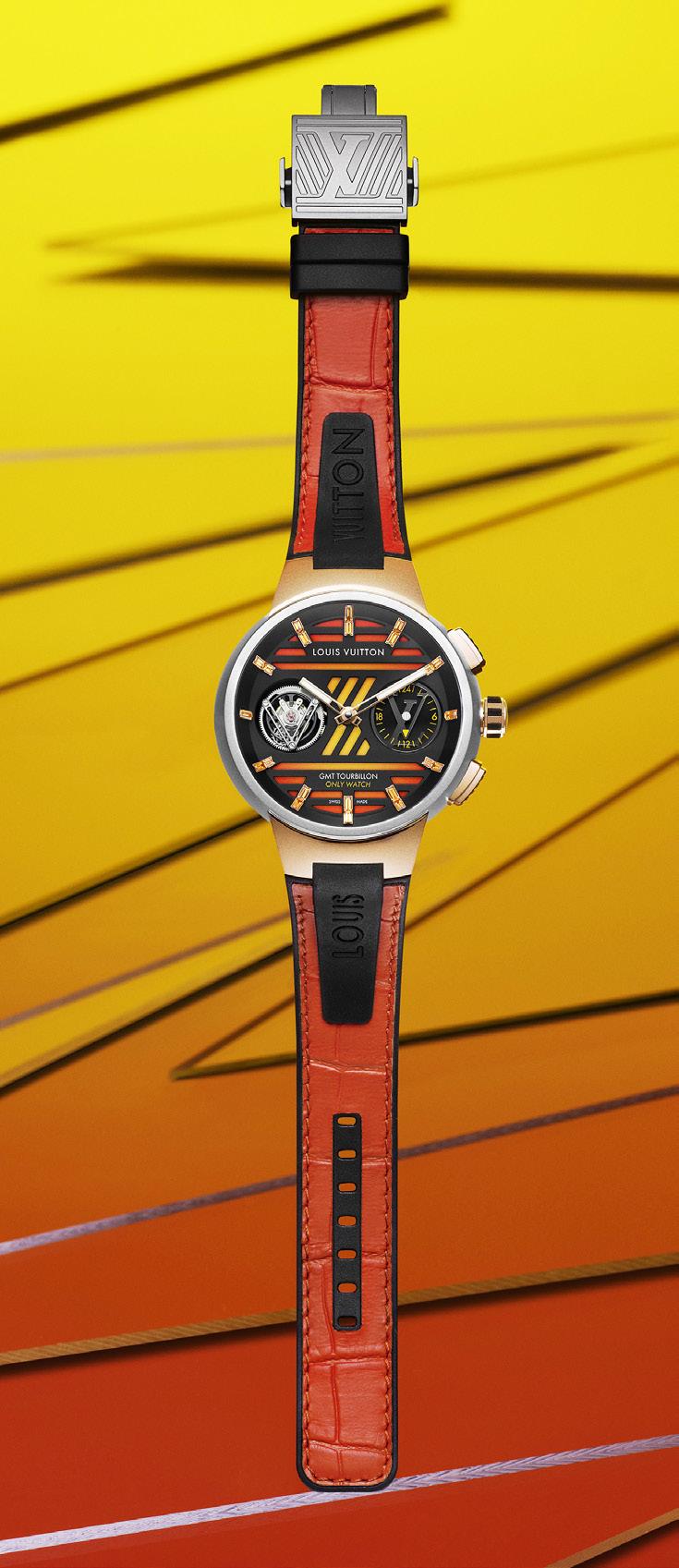


A wonderful bookstore of wonder, the Maison Assouline on Piccadilly in London. Not always easy to get so many of their books together in one place. Inspiring how they still highlight so many different authentic passions.

Time passes irrevocably.

